#(and considering the only card game we really played was MTG)
Explore tagged Tumblr posts
Text
y'all bandai themselves is assigning me with the apocalymon autism
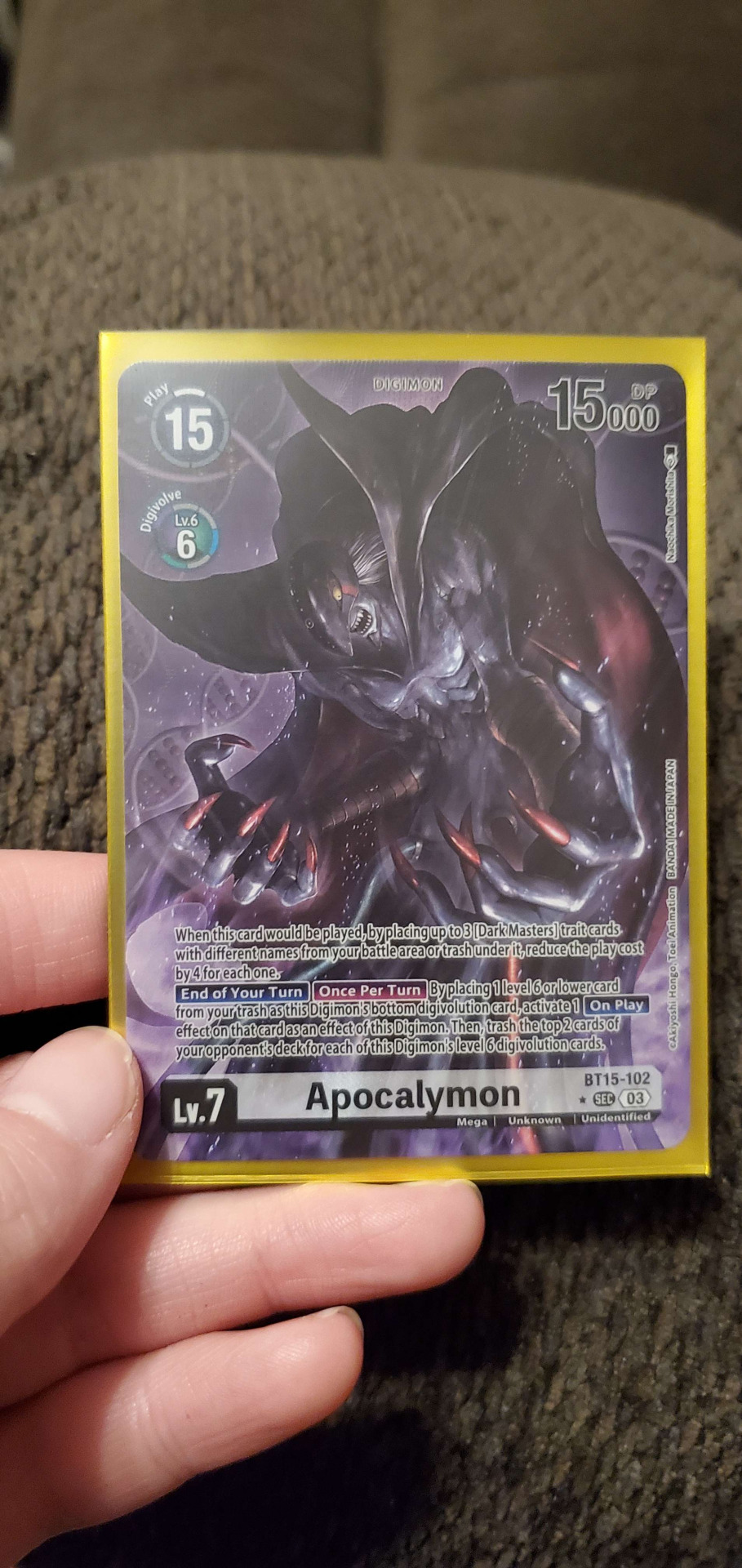
[ID: A photo of a someone holding a copy of the parallel art of Apocalymon from the Exceed Apocalypse expansion of the Digimon Card Game. The alt art depicts Apocalymon's humanoid body with an intense expression. The card itself is in a gold sleeve.]
we only bought four packs (the first time we have bought packs since 2021) and this was the last card in the last pack
we're getting the whole pizza with this one fellas
#sky talks#digimon card game#yes i know apo is a restricted card#but i have that apocalymon autism real bad right now so even though i barely know shit about DCG#i'm like determined to make it work#also the dcg tutorial app is really good for what it is but. god damn.#i am remembering why we stopped playing card games in college because worrying about interactions is a pain and a half#one game takes me like 30 minutes minimum even with the app making the flow easier for my brain#anyways#when i tell y'all i screamed#i could not chill for about an hour after this#he came home fr#now i feel like i HAVE to find a FLGS that actually has people playing digimon lmao#(as if i wasn't already gonna try to)#ALSO having not played card games since like? 2018?#(and considering the only card game we really played was MTG)#i am losing my mind over how pretty and intricate foil cards are nowadays???#like i also collect pokemon cards and YES there are some very gorgeous older pokemon foils#(there's this one pidgeotto card with starburst sparkles that is dazzling)#but the intricacy of the pattern work in some of these foil cards is nutty#i have to wonder what kind of tech goes into making card art do that#anyways uhh#i'm going to bed now that i've spent 6 hours riding this high#download the DCG tutorial app
7 notes
·
View notes
Text
Counterplay: Increment Commentary

There were a lot of mechanical variants this past week, and a lot of variations on the same mechanical aspects. Amassing, and card draw, and +1/+1 counters on green creatures... Yeah, there are only so many things you can increment in so many ways. I'm kind of surprised by the amount of variance even within those similarities, though, and it's clear that people liked forging their own paths!
Decades of mechanics and precedent allow us to select what designs work best, how they work best, and what kinds of aspects of MTG will show up when we need them to be bigger and better. I think the one suggestion I would give generally would be to consider the play patterns based not just on your own imaginations but also experiences from limited, from standard interactions, from the world in which everything is a little bit reliant on everything else. There were big swings between ambitions and precedent, mechanically and flavorfully.
There were also arguable differences between what I consider precedent for increments and what's technically incremented, so keep that in mind. Some of this—actually, all of this, because I'm the judge—is my opinion for what I was looking for in terms of direct increments. So keep that in mind: my opinions are totally fine to hand-wave on that front. I'd like to think you're still here because you care about the parts where I say what I think works and doesn't work otherwise, but that's ego speaking.
See a card marked JUDGE PICK? That meant that I liked it enough to either point out something super specific about it or it was in the running for the podium before paring for space. Read on until you're accumulated all that knowledge.

@bread-into-toast — Sprout of the Hate Seed (JUDGE PICK)
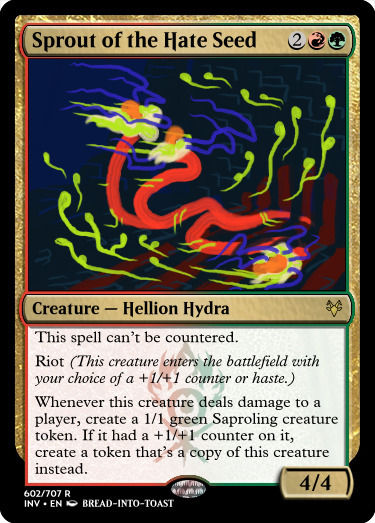
Calling combat triggers "incremental" is technically true, but not precisely what I was thinking of for this contest. That goes even more so for the optional trigger there. But maybe I'm being too narrow with my internal definition of "will happen every turn" versus "may perhaps happen every turn," because some of those example cards did kinda get there. I think part of my internal view was considering that you were the one in control of the increment. BTW, all of this is me waxing and musing, so for you and your card specifically, I'll say that this card really got me thinking about what I wanted to mean by increment and what was unspoken. Kinda on me for that.
I do love this card in general, though, although I'd change that trigger to: "Whenever this creature deals combat damage to a player, if it had a +1/+1 counter on it, create a token that's a copy of it. Otherwise, create a 1/1 green Saproling creature token." The reason is because it could be argued that the "it" in the second sentence could refer to the Saproling, or at least someone might be confused by it. Everything else is perfectly awesome for a Gruul design—swingy, big, potentially game-ending, and the kind of rare that would sway you in limited into these colors. Swell job!
~
@cthulhusaurusrex — Elvish Growthcaller / Embodiment of Growth
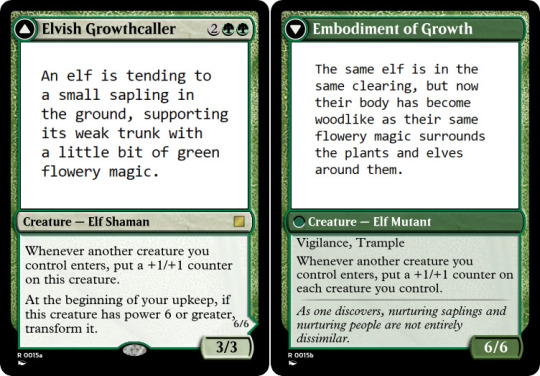
Big effects into bigger effects are incremental enough, sure. Transforming into Cathars' Crusade on a stick is pretty excellent, and with enough lords or other effects I think that this card could be absolutely powerful when it transforms. The design itself is fine and would be a snap-pick if you're anywhere near green and/or if you wanted to hate because you didn't have the right removal. Mechanics are fairly standard, and that's all good there. I suppose the world around it and the vibes are what I wanted more of, so let's talk about that.
What this card is depicting is the healing/lifegiving power of a young elf that transforms them into a leader amongst their people. This is one of those cases where I feel that "elves connecting to plants" could have used some kind of emotional crutch to separate it from... The word I'm going to use is "expected." This is all flavor talk, so feel free to skip it, because the only actual chance on the card I'd do is making the T in Trample lowercase. For flavor reasons, though, I don't yet feel that kind of surprise that I need to make these fairly straightforward mechanics feel fresh again. Is this an expected mutation among the culture, or a surprise gift of the world's magic? The flavor text isn't giving me anything new here, and its vague poetic styling needs to provide that sense of strangeness, transformation, or change.
~
@dabudder — The Hype
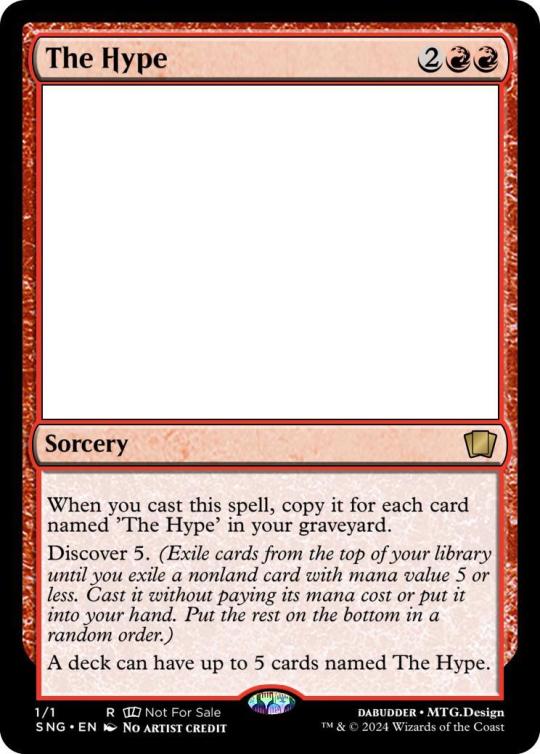
I get this card, for sure. Totally do. It's absolutely not what I was looking for for increments, as it relies on a lot of non-deterministic factors to do...well, anything. But man. The first thing that comes into my head is Throes of Chaos, but much different. I suppose you could search for The Hypes, get them into the graveyard or whatever, but once they're in the graveyard then you need at least one to get it going... And then, to what end? The hype feels kinda let down by having only one extra copy, but having too many would be way too wild. Chain together The Hype until you hit two five-mana-or-less combo pieces, what a deck. Isn't that basically how this deck would work? Geological Appraiser got banned in Pioneer for a reason.
The main point is that this card can only get so big before the hype dies down, unless you're using The Hype to win on the spot. Limited probably wouldn't use this card (although not every card is designed for it, so that's aight) except as a maybe one-off ramp. "Find your combo piece" is effectively all that you'd be doing in constructed effectively. Maybe the randomness being let down by The Hype copying multiple pieces is okay, but even then, this isn't the kind of scaling that's right for an increment contest. What happens at the top? Via the card itself, nothing much. It's hard to evaluate a card that effectively is designed around only itself without assuming the most broken intentions.
~
@feyd-rautha-apologist — Grassy Gnoll (JUDGE PICK)

I imagined this card to be a build-around sleeper hit for constructed. Pinging your opponents' creatures doesn't have to be massive to be effective, right? And if there are two of these things, well, you're in for a treat. It's the return of Temur Staticaster combo! That's all just hype, though. The narrowness of this card at uncommon meant that it wasn't exactly slated for a podium spot given the fact that we had an immense number of awesome cards. Still, despite the name being something that perhaps wouldn't pass the marketing team, I think this card's pretty wonderful.
And aside from that, there's not much of a second paragraph to add here. The "W" in "Ward" should be lowercase, so jot that down. I do want to say: I think that the shortening of a card name to "this creature" was a mistake on WotC's part. Later pronouns can increase text to decrease the following confusion, although this card clears it up enough with the "that" later on. All the same... Look, this card feels great—it eats, shoots, and leaves. Leaves you with an arrow in the back, anyway. I love hyenas and I love the vibes. What more can I say?
~
@frognarch — Avalanche Elemental (JUDGE PICK)

Conversely to the previous card, you could use "this creature" here and I'd be none the wiser. But! This is one of those copying effects that distinctly feels incremental, and by far stronger in limited for it. Evasion and copying and snowballing, well, that's pretty wild. The only question I have for limited power is whether or not the fact that it can get exponential is too much. Blocking the token copy can wear it down for the moment, but if you get a single copy to stay, the board's basically done for. Every turn, swing and swing and swing again. These days, though, a five-mana 3/3 is pretty low. Maybe the environment would redefine it? Hard to say.
I do really love this design, though. I'd replace the "and" with a "then," or just remove the comma from behind the word "combat." Those are the minor potatoes. As for the flavor text, I'm iffy on a couple counts. Firstly, that's not how avalanches happen so jot that down for your nerd notes. Secondly, though, that line of just "the snow fell" doesn't carry much weight with it for me. The card's intent is that these elementals are rising from the alpine and barreling down uncontrollably, but the flavor text makes it seem like the army just got buried in a particularly heavy storm. It speaks to the aftermath rather than the moment, and the card's energy is carried with that moment. Y'know? Gotta match the energy to the action.
~
@grornt — Mangrove Stalker

I'll start off by saying that it's a generally phenomenal design and you should keep this in the files. No notes there. I'll follow that up with the unfortunate part that it doesn't feel quite as incremental to what I was looking for for the contest. As soon as this comes out, you can pop it and get your benefit if you have enough creatures in the graveyard. Inversely, I was looking for a card that started the buildup itself and used itself as a requirement for bigger effects. There's the technical argument, and then the vibe argument.
I guess that this is a design lesson for me for contests. Most of the vibes were totally met, but this is a card that just doesn't hit that specificity for me. All of the values are subtle and I was actually hoping that people would be less subtle this week. I know, shocker! But if this creature got 'stalking counters' whenever you milled a creature or whatever, then drew for each stalking counter, that would be more in-line with the intended increment. And that would, in my opinion, make for a worse card. What happens when a good design clashes with the bespoke niche? I mean, you get me waffling for two paragraphs, that's what.
~
@helloijustreadyourpost — The Book of Grudges

Multiplying your power as a punishing effect for attacking hurts a lot. Even though your creatures can't block, a single attack from your opponent the turn after you play this will create an additional four power on board, and then six the next turn, and so on and so forth. Yeah, it's a three-mana can't-block token. But we've all heard the adage "math is for blockers," and that really makes this card feel like it's doing more than it should be able to. Landing this early in limited is a game-ender without removal. Landing it late can change the parity immensely—if you have parity. I will say that the can't-block addition is the best choice for ability balance. (Or in this case, cannot-block. You should change that to the contraction.)
Personally, I'd do one of two things: either I'd limit the number of counters that can be placed on the book (which would be okay but not great for the contest, and would add a lot of text), or I'd make the creatures 1/1s. I am also curious about the flavor here, because I want to praise the subtle humor and the cool worldbuilding piece you've made here. Presumably, you have a group of dwarves on whatever world (I'm thinking Eldraine or Kaldheim) with a massive tome of their wrongs that incenses them to combat in a way that's more aggressive than thoughtful. Shortsighted and grumpy! That's a great way to use names and abilities together to create a sense of grounding without even needing art direction.
~
@horsecrash — Bubbling Brew

The design: super cool. The flavor: perfect use of those counters. The math: weird. Too weird. Hold on, I'm actually going to get out a deck and muck around and see how it feels. ... So, I just tried this in a Sultai midrange kind of deck. Played it on turn three. Turn four: basically no hand, played out a card. Turn five: lost a lot of life, but drew cards. Didn't want to play anything because of the life loss. Turn six: draw a lot, lost a lot. I basically didn't want to play any of the cards that I drew because that meant the next turn I'd be incrementally losing all of the other resources.
Quite frankly, I want this effect to be symmetrical. Smokestack-style. Standard can handle it. Or there has to be some other kind of way to mitigate the life loss, because you're discarding so many cards that you're losing basically everything you get at the cost of your life and eventually there's no way to play out all that you have so you just mill yourself or drain yourself. I think this was the first time I've actively played a card in a deck that it was probably intended for, and lemme tell you, it's worth for anyone to do for a card this ambitious. Pros: ambition, flavor, uniqueness. Cons: my life total :(
~
@hypexion — Ignition, Errant Arson / Cataclysm, Vengeant Inferno
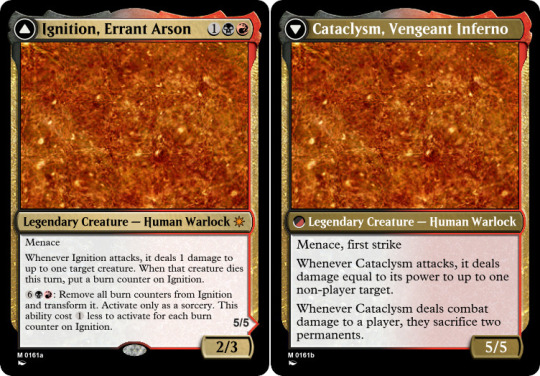
The design is decent, but I'm left with a lot more questions than answers. Let's go through those first, because the second paragraph here is for sure going to be talking about the cool stuff you're doing. I feel that the increment-specific design is intended to be like Animar, in that your costs go down with the incremental uptick, so that's understandable. But it feels so localized, and this is a personal thing, but I think the intent of the contest was more universal to the board? Still, out of the technicalities, it makes a lot of sense to me with the buildup. The names are baffling me, though, because I can't place them at all. I assume these are chosen names, but they're... I don't want to say that they're "obvious" for the archetype. "Telling" is the closest adjective I have.
Mechanics are surprisingly in-depth, though, so let's have some fun. Firstly, menace plus potentially killing a small blocker is a great combo, and depending on how much an opponent is forced to block, that may be a perfect way to get those counters, discounting burn/combat tricks. Could even be worth making the front side a 3/3. "Non-player target" is also a great choice on the backside—accounting for Battles, I assume? The only wording choice on the back side I'd change would be to switch first strike and menace (see Kari Zev et. al); I thought "they" should be "that player" but I guess your wording is accurate as well! Both work even if I prefer "that player." The bombiness and dedication to the theme is on point, even if some of the details are evading me.
~
@izzet-always-r-versus-u — Tyvar, Hero in the Dark

Sorry about not saving this one the first time—I definitely saw it, and I went through the inbox a second time, and it just flew under the radar. So let's talk about it now! And part of that is me wanting to hear the thought process for this card, because as a mythic, it's possible that it's really good, but I'm not entirely convinced. Omen Hawker was the first card to come to mind, although this one is distinctly more powerful—but just as narrow. Here's the question I'm left with: in what environment would this be considered a mythic in terms of gameplay versatility? Where are the most activated abilities that one would want to do postcombat or during combat?
Maybe it's just me, but I feel that this would've been a fine rare instead of a mythic. The general design is fantastic, though, and it works quite well with the other Tyvar. And, I can see from the past precedent that Tyvar has a little bit of "activated abilities matter" from the past. Everything shows that you've done your homework here. I feel 'whelmed' by the overall effect, though. Attack, counter, make mana—that's all fine. Where do we go from here? Boasting is potentially valid, I suppose, but again, I would liked to know a little bit more about your vision. I'm imagine there was a lot build up in the process that maybe didn't translate into demonstrating this card's utilitarian strength. (Also: love the name, 10/10)
~
@melancholia-ennui — Creeping Misery (JUDGE PICK)

Yep, that's an alternate wincon for black, very much in the spirit of the contest. Once more we're delving into the world of black enchantments. Was there a particular reason we had six mono-black enchantments this week? I'm not creeping on anyone's misery here, but I find it fascinating. Anyway! Underworld Dreams is one of the first cards that come to mind when people think about BBB punishing enchantments, but this card's more along the lines of... Well, it's got quite a pedigree! Bloodchief Ascension, Fraying Sanity, and more... And yet it's not until you start to pick apart the card that you see how all these influences turn into something original. I think that it's reasonable to call this card more of a constructed build-around but the limited potential is there.
And in limited, you're going to have a lot fewer chances to save yourself and find answers if this hits the board, because things will be trading all the time. You only need one copy to lock someone out of the game, because everyone's going to be getting rid of creatures, especially you. Having that BBB restriction to prevent this from being even remotely splashable ensures that only dedicated decks can make it work. Obviously it's a pain in the butt to deal with for limited, but some cards are just like that. With our limited space this week, I still wanted to showcase this card for being overall just plain good. Pedigree matters sometimes, and this is a well-worded well-executed enchantment. Thumbs up!
~
@nine-effing-hells — Exponential Grower

I completely forgot what expend was for a moment there. For anyone reading this who also happened to forget, expending was the raccoon-themed mechanic of Bloomburrow where you expended X as you spend your Xth mana to cast a spell in a single turn. I think I understand expending as a mechanic that would be reasonable for Strixhaven! You have these students who are putting a lot of mana into casting bigger and better spells, so that's fair, or maybe Quandrix could just be that home, as they're a growth-themed school. I think reminder text might've been appropriate, though, because let's be real, expend was...not a memorable mechanic.
As for how this card works, I think incremental growth is a little bit problematic, because it essentially tops out at eight unless you're playing a massive EDH game, and this card isn't especially playable except in those unworldly dedicated decks, which have other and better options. Having a 16/16 trampler isn't bad by any means, of course, but in terms of incremental cards... Well, maybe I'm being too strict with the definition, because getting that 16/16 is pretty rad. I guess between the top-off and the expend stuff, this card feels decent—but that's about the limit. I'd like to see this card in a Quandrix-expend-Strixhaven world, and it's a fair design. Having the limit be pragmatic instead of mechanical doesn't feel great for this contest, but I wouldn't really change the design.
~
@piccadilly-blue — Press Gang

You said it yourself in your submission, so I'm not gonna go gushing over this card as a paramount of progress. It's good, though so liiiiiike... Anyway. Getting more and more power with your Pirate Army is going to get out of hand pretty fast, but not in a way that's not deal-with-able, considering, like... They're two creatures that can be fought against with the various tricks in black and white via combat and in green via big stuff. But, you have extra help with evasion to get your Treasures in these colors, so you're gonna have that going for you. Is it any surprise that this card's pretty much exactly what's reasonable for a set that would call for it?
The flavor text is good as well. I can see the head of a gang walking down the port with a sword in hand, smirking as they lead a hooting and hollering band of miscreants. It feels a little off that there's no Threaten effect with this card, though, and considering that there were other effects like that in the Ixalan era of piracy, I wonder if there was an opportunity to have that come up here? Maybe the flavor text could've been more in reference to bigger crews having more fun or whatever. I guess that's not the point, though, and again, not bad at all. Take a pat on the shoulder and don't check your pockets until your wallet and I are at least two states away.
~
@real-aspen-hours — Incremental Research (JUDGE PICK)

Remember to get your rarity on if you're doing text submissions, folks. But that's neither here nor there, because I imagined and hoped that this would be a rare card. Plenty of research goes into making this work for sure, and it's one of those things with high risk and high reward. After a certain point, there aren't going to be many spells left unless you're doing X spells. Where I really see this popping off is with extra turn spells. From mana values 5-10, there are a number of excellent ones. I guess that's if you're playing solitaire, though; normal burn/control/value stuff is fine too.
I think this card significantly rewards strong deckbuilding. It's possible for this to be playable in limited if you really work for it, even if it becomes not very useful after a certain point. But isn't that part of the flavor? You have to do your research, you have to really make it work, you have to use your knowledge. It wouldn't fit this contest, but I think this card could've been even stronger if you were forced to either add OR remove a counter from the enchantment. Still, that's messing with other powers, and doesn't help for this card for this specific contest. It's pretty good overall, and I like the choice of skill intensity.
~
@roxbot — Furnace, Fierce Protector

This card could be perfectly fine in the right environment. The major issue is that, for all intents and purposes, it's a french vanilla mythic that doesn't do anything but get bigger. It doesn't necessarily affect the board, but it plays into a couple of specific strategies, perhaps. Looking at what's in Standard right now, there's not a great comparison. The question of what this card does hangs over it. As I was reading it, I actually thought that these were oil counters and not charge counters at the beginning, and that's a whole other thing—what kind of deck do you have to build to make this work, really, and is it worth it just for this kind of body? I'm not entirely convinced, even in a set that would use an immense amount of charge counters.
Couple of wording changes, by the by. Names are usually replaced by "this creature" as of Foundations, and that would work best here. The "on permanents" should be "among permanents" in the first line. Rules things: if you have no charge counters out when you play this card, it'll actually die as a state-based action, because when the spell itself resolves the P/T check will see it as a 0/0 before the trigger goes on the stack. That's why cards like The Mimeoplasm are worded the way they are. Last note, "start" should be "beginning" there. Overall, I think there were a few tweaks, but the base judgement is that I feel the power level is too low and too narrow for the impact it needs.
~
@sparkyyoungupstart — Detesting Beast
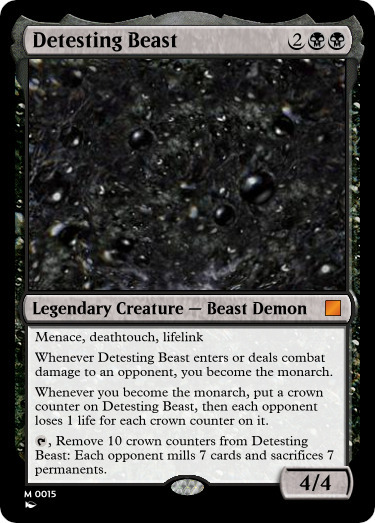
I think that this card would be awesome in a multiplayer set or in a Commander precon! I also think that introducing the monarch mechanic in 1v1, for which you are designing, has led to several problems and I'm not gonna wax poetic about an issue that everyone and their cat has been talking about for the last thousand years. Anyway. Let's look at the design choices from THAT perspective. The general take: this card's fun and you're gonna be pretty detested by the end of the game assuming that nobody has removal for it. Nobody wants to be hit by this, and nobody wants to give you the monarch for sure. Everyone suffers. I like that. Puts a good threat out there.
All these synergies makes me really wish that you had actually gone and done a Questing Beast variant with three different mostly unrelated takes like how the original QB had done, though. I think part of QB's strength is the fact that it's just a pain in the butt for different reasons, as opposed to this card with has many reasons but one specific track for it to be awful. The only wording change is to change the 7s to "seven"s. I also like how damage to ANY opponent will yoink the monarch back, BTW, very subtle. I hate this card! I would love to play with this card.
~
@tanknspank — Rats' Nest (JUDGE PICK)
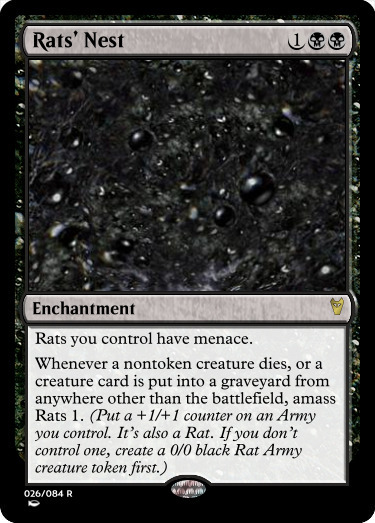
Very curious if you were going for Eldraine or Ravnica here, but either way it's a great use of the name and of the typal agenda. I think Army technology makes a lot of sense for increments overall as well, so I'm glad that folks were using that a lot this week. I'm okay with it being used here not just because having "amass rats" is an awesome thing to see on a card, but also because, yeah, it's just what this contest could want. Get a big enough rat and you're forcing your opponent to make the rat bigger. That's pretty great!
There's just no guarantee that this card's going to get going, and for that reason I wouldn't make a P1P1 out of this in limited. Not that you'll never have rats or that things won't die, but with the right kind of evasion and alternative removal, it makes it difficult for you to 100% guarantee that you'll find a large enough rat to make this card really pop off. It's not a bad rare; it's a slow rare for sure, but eh, what're you going to do. The general vibes are exact, the card's going to do what you want it to in a dedicated rat deck that's not one of the gimmick decks, and so we're all happy with what we see here. I'm really feeling more sewer-y Ravnican rat nonsense with this, but I couldn't tell you why.
~
@wildcardgamez — Benevolent Scalelord

Cumulative upkeep and bolster are two mechanics that I really don't see being that great together, even with the things that you use to make it...well, this. The reality is that cumulative upkeep isn't a great mechanic and wasn't that good even in its heyday; it's a 10 on the storm scale for a reason. Bolster is also one of those mechanics where you're stuck in a strange spot with the kind of creatures that you're able to put counters on, but that's one where I'm more of a personal meh-sayer. As it is, though...why is this a dragon hydra? What kind of weirdness justifies that? A dragon without flying could have hydra-ness in it, but if the two are coming together you bet I'd rather see a flying hydra than a grounded dragon.
The idea of big counters that transfer over to another creature upon death isn't a bad idea at its core. This particular card has a mishmash of strangeness that leads me to wonder why they'd ever be together for a premier set. I feel that the lesson to be learned here is to focus the backwards-looking lens on what should be returning rather than what would be good for a contest. On top of that, the excitement of ideas should reflect the best of both worlds rather than a compromise. Did this need to be a dragon at all? Could you have brought bolster to another creature type?
~
@xenobladexfan — Bloody Knowledge

"If you would draw one or more cards during each of your draw steps, instead put two deal counters on this enchantment. Then you draw X cards and lose X life, where X is the number of deal counters on this enchantment." is how I would word it. There are a few precedent-y cards to go with that, but this is a pretty convoluted card as it is. Drawing two and losing two, then four, then six, then eight... I mean, hey, that late in the game, you better be ready to make some sacrifices. I think that the addition makes some really rough deals out of this spell, but it's a mythic black card draw thing, so for standard sets it's as powerful as you're gonna get. Maybe 2BB would be fine, but that's pushing it just to keep things even.
I guess that the most important thing about this card to critique is the fact that it's pretty much a stripped-down flavor for bargaining, to the point where there's little meat left on the bones. Bare bones are good for chewing, but there ain't much blood in them any longer. Sometimes the basics are important, but there's zero context for what's happening beyond all the "give up blood for knowledge and power" spells that we've seen before. I think that this card needed a little bit more of a personal story touch for me to feel something beyond the good-mechanics. Again, there's nothing inherently wrong with the tropes—it's me personally that's wanting more.
~
@yd12k — Sphinx's Grasp

I'm ashamed to say that I'd build around this card. It's a looping wincon, where you can play one, counter a spell, then hold up counterspells in your hand for the rest of the game and then just loop them once or twice a turn until you have literally all the power you could possibly need to strip them of their resources. As a limited card, nobody would play this. Constructed? Absolutely revolting as a wincon and I'd play four of them in a bounce-control deck. The gist is that this just isn't a good play pattern for constructed at all.
Even an uncounterable meta would have a difficult time if this were combined with literally any other aspect. Oddly enough, I'm reminded of Lullmage Mentor, although the ceiling for that card was significantly higher than here. But for that, it's a once-a-turn possible lock. This card is an active wincon that permanently removes further resources. I don't think that there's a world where I can really justify this card, as much as I like it.
~
@yourrightfulking — Invasive Briar

The give-and-take is interesting as a card. It's definitely not what we're looking for for increments. What's increasing, exactly, and by what? The lands that you get to put on the plants can be replayed if you draw into them, but nothing gets bigger the more that something happens. The more lands you play doesn't necessarily correlate to the increase in plants, and the growth of the plants isn't necessarily tied to the fact that you're playing the lands. Give-and-take is a different kind of technology here. I do like this card, though, so take that for whatever you will.
I actually really like this as a limited bomb, to be honest. You can drop this and then do absolutely nothing but play out the rest of the game until you can get a plant army going to annihilate your opponent with your spare lands. Like, that's a fine game plan that requires forethought and survival without being a brainless exercise in abundance. Multiples are a pain and can get overbearing quickly, but there are far more answers in constructed. I think that there are other ways to flavor this to make it a little bit scarier or funnier or more immersive, but that doesn't take away from the mechanical cohesion. Good card...for a different contest.
~
Have fun with myths this week! @abelzumi
8 notes
·
View notes
Text
my top 10 favorite new commanders from 2024
as we wrap up the year, i wanted to take a moment to celebrate some of my favorite new cards of the year! notably, i'm only going to be considering commanders i actually built or at least theorycrafted. i do tend to at least theorycraft anything that really catches my eye, but this list is going to be heavily weighted towards what i personally enjoy playing rather than what might broadly be considered the “best” or most powerful commander.
10. (tie) kellan the kid & yuma proud protector


i agonized over this last cut for a while, i even looked really hard at the rest of the list just to make sure i wasn't being too precious about any of the other commanders, but in the end this is just a straight-up tie between my two favorite cards from outlaws of thunder junction. (ok, yuma is technically from the commander set not the main set. shush. you know what i mean.)
these two are also notable for being in my two favorite color identities, bant (the color identity i currently associate myself with the most) and naya (the color identity i used to associate myself with the most). and for both being led by characters i loved from the official story. (maybe you can read about that in a forthcoming post! who can say?)
lands are my favorite card type by a pretty wide margin so a lands-matter commander like yuma is always going to get my attention. kellan, on the other hand, is just a fun commander who cares about casting spells from places other than your hand. he encourages unique play patterns (one of my favorite things a commander can do), and he made me look at a lot of cards i wouldn't really have considered in most decks.
9. the infamous cruelclaw

if mere power alone were my primary consideration, cruelclaw would be at or near the top of my list. i like to tell people that selesnya is my guild and rakdos is the guild i flirt with at parties in hopes they'll take me home & leave me with some hot bruises, and perhaps nowhere is that better illustrated than in my ninth favorite new commander of the year.
ok, let's get this out of the way. this weasel is hot. i mean, just look at him. and he's a sadist on top of that??? genuinely unfair, wizards. y'all knew exactly what you were doing.
as for how he plays, clearly he is quite a bit spikier than most of the commanders i build. you're just looking to connect with him once and then cast bonkers value for free. imagine a turn 3 eldrazi titan or sheoldred. yeah, oof.
cruelclaw is a kill-on-sight commander, and it's pretty rare for me to go into a game wanting to establish myself as the archenemy on turn 0, so it keeps him from being much higher on this list. but he's also a character who is so pretty he makes me dumb and a commander that emcorages a very unique, very fun (for the person playing him) play pattern, so there was just no way i was leaving him off my list of favorite new commanders of the year.
8. alesha who laughs at fate
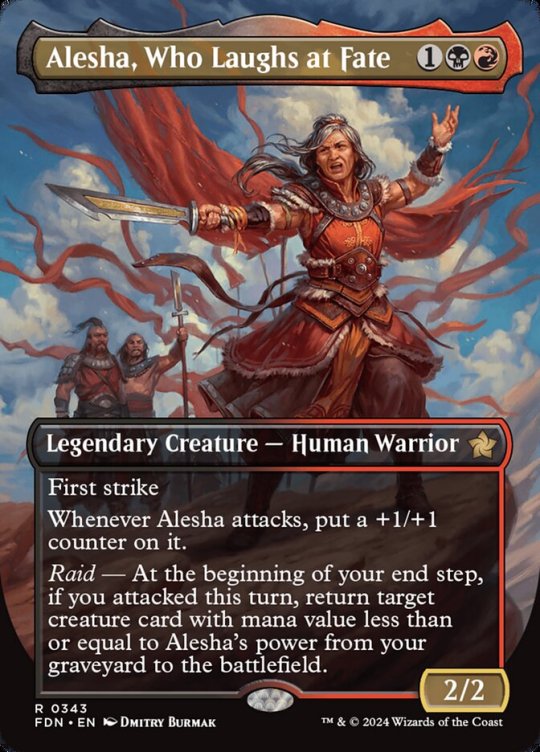
speaking of how rakdos is the guild i flirt with at parties, why hello magic's first canonical trans woman (and star of a lot of people's favorite mtg story of all time) appearing on your second card ever! i built old/mardu alesha into probably the most cedh-adjacent deck i've ever built, and she's a beast. capable of winning (or at least knocking one player out) out of literally nowhere. as much as i love the character and as proud as i was of the deck, i very quickly felt like i got as much out of it as i really could, so i'm really happy to see one of my favorite characters of all time get a less powerful but still very fun card.
reanimator is not an archetype i build very often, but i really like the design of this version of alesha. her raid trigger is essentially a drastically less broken version of her old card's reanimator effect. for instance, she doesn't enable the master of cruelties combo that is capable of one-shotting an opponent out of nowhere. but she's still a value engine of a commander who encorages you to swing in every turn, which is just an incredible translation of lore to game mechanics.
also i know this is the gameplay list not the story list, but i'm a vorthos so any list i make is gonna be at least a little bit vorthosy. and i just gotta say, the clues that alesha is somehow still going to be alive when we go back to tarkir thanks to some timey wimey shenanigans are really starting to pile up, and i am so ready to be right about a tin foil hat theory i've had since march of the machine for the absolute dumbest reasons.
7. thurid mare of destiny
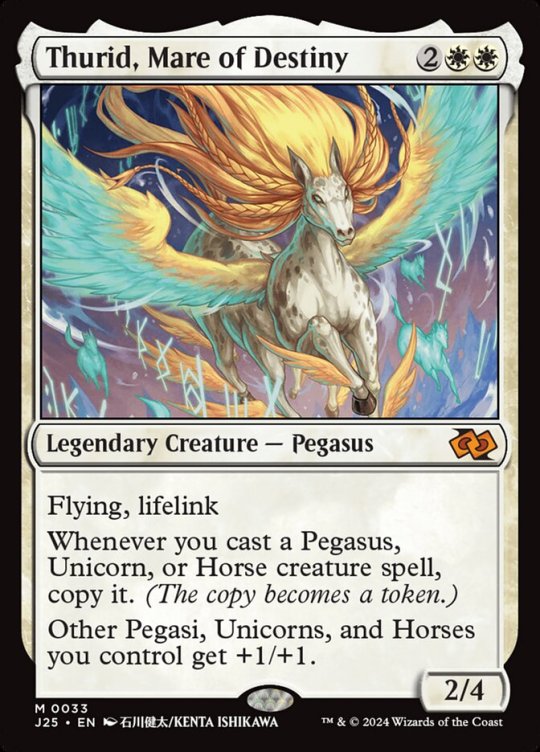
i built this one for my boyfriend, not myself, but it's so great to finally have a deck that can unite all the horse girl creature types and the end result is dang fun to play. forget clunky lifegain & +1/+1 counter synergies, how about getting a copy of every single horse, unicorn, or pegasus you cast? i'm a sucker for kindred decks, but thurid brings something genuinely unique to the table for some of the game's most neglected creature types.
6. baylen the haymaker

i love token decks, but it's hard to do much better than my beloved cadira caller of the small as a token commander. fortunately baylen goes about being a token commander much differently than cadira and many other token enablers. rather than simply trying to flood the board with a lethal bunny army (in fact, he doesn't even generate tokens himself or amplify other ways of generating tokens), baylen gives you ways to capitalize on the tokens on your board to generate resources. tapping two untapped tokens gets you a mana of any color, three draws you a card, and four gives your bunny boy commander a +1/+1 counter and trample.
cadira is arguably my best deck, and even the clunkiest build of them threatens to steamroll decks of theoretically similar power levels thanks to the inherent snowball effect of their triggered ability. i like playing them at a stronger power level because opponents usually have the boardwipes and other ways of dealing with their adorable but deadly bunny army to keep the game fun & balanced.
baylen can absolutely be built to be a beast of a deck, but you can also build him to play against precons & battlecruiser decks like i did. that kind of versatility, plus the fact that the game's designers are still able to find new design space in an archetype that's been around for literal decades, makes baylen one of my favorite new commanders of 2024.
5. delney streetwise lookout

first of all i feel personally attacked by the fact that this card dropped this year. karlov manor feels like it was years-plural ago, not at the beginning of this one.
i love building monocolor because the manabase doesn't bankrupt you and there are so many interesting cards that only make sense in a monocolor deck. i loved building delney specifically because it gave me a reason to look at basically every single white creature with a power less than or equal to 2, and because they're a canonical enby whose entire vibe is just so effortlessly cool.
and who doesn't love getting to say “trigger, trigger” every time an ability triggers because it's happening twice?
4. helga skittish seer

ok yeah ok fine this is a vorthos list, i'm sorry, every list i make is secretly a vorthos list. but if you've read the bloomburrow story and don't think helga is the best character ever, i just don't know what to tell you. (and if you haven't read the bloomburrow story, i know exactly what to tell you: go read the bloomburrow story!)
helga was a very fun deck to build because her entire deal is basically “if you aren't a ramp spell or an expensive creature, i don't want you in this deck.” pretty straightforward! she's also in my colors, and to reiterate she's a wonderful bean and i would protect her with my life.
3. ms. bumbleflower
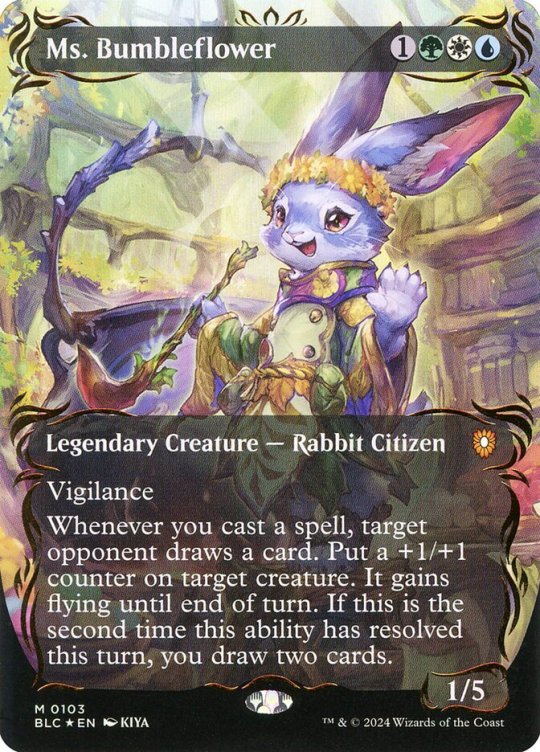
i love so many things about this commander and the kind of deck she wants you to build around her. the entire idea of group hug decks is wonderful (though i had to make some pretty major changes to the precon to make it actually a group hug deck), and i take some genuine pride in the fact that i simply would not have been able to pilot this deck effectively a couple years ago.
2. voja jaws of the conclave

a commander for two of my favorite types? in one of my favorite color combinations? with very strong story connections to my guild? wizards, you shouldn't have!
look, i know some folks are salty about voja's perceived power level, but seriously please calm down all the way down? he's a 5 mana commander who doesn't do anything until you untap with him. he's not getting played at cedh tables. and if you don't find the idea of a wolf bossing a bunch of elves around hilarious, i kind of don't want to be friends.
1. dionus elvish archdruid

as awesome of a commander as dionus is, there is a world in which they* didn't even make this list instead of being on top of it.
i'm an elf player, so as soon as dionus was previewed, i knew i needed them. but i already have so many great elf commanders i was thinking of them in the 99 of one of my decks, not the head of their own. what kept them from sharing the fate of the year's other exciting new mono green elf legendary (eladamri korvecdal) was exactly one letter: u (for uncommon).
for those who don't know why that's significant, that makes them a valid commander for pauper commander. and folks, they are busted in pauper commander. but what makes them my favorite new commander of 2024 is they are the elfiest elf that ever elfed. they reward you for tapping creatures? are you serious? how did we not think of this until now? elves get tapped so often you'd better take them out for dinner first. i'd be jealous if i weren't an elf! what an absolutely perfect concept for an elf commander, and that's why dionus elvish archdruid is my favorite new commander of 2024.
*dionus has exactly zero lore that isn't flavor text attribution, so i have no idea what their pronouns are.)
7 notes
·
View notes
Text
From the Archives: Wilds of Eldraine Prerelease
As I recently did the Bloomburrow Prerelease, I thought I’d look back on my first prerelease, which happened to be my first in-person Magic event since getting back into the game!
I was writing some logs at the time on my experiences but didn’t post them anywhere. I still remember how much excitement I had coming out of this event, just it being my first tabletop Magic in person in like 25 years. Let’s see what I thought at the time!
Archive:
First ever prerelease event and first time playing in-person MTG in about 25 years!
I’m given my prerelease kit which contains a promo card Restless Vinestalk and six Wilds of Eldraine draft boosters from which I need to construct a 40 card deck. I open my packs and then sort all my cards by color.
While I had some nice white pulls, I knew that I needed to focus on creatures and interaction. After sifting through all my cards I eventually narrowed down to green and black for my deck.
Match 1: After the construction period, the Magic Companion app tells me where to sit. I’m put at Table 4 against white/green. Can’t believe I’m about to play my first game!
Game 1: Got out some creatures and damage, but he had a flying griffin that was just too strong and ultimately beat me. I had seven mana up for Virtue of Persistence but it was worthless to cast as I needed an answer. Went into desperation mode digging via my Collector’s Vault finding a flier to block one turn but inevitably nothing else.
Game 2: More of the same considering decks are only 40 cards. He was able to pump up creatures with Royal Roles, copying them as well. I was able to take his flier by casting a fight spell targeting it versus my Scream Puff, but his tramplers were a problem. Ultimately ran out of time in our match and he was ahead on life so he was awarded Game 2 (though he was in control anyway) and subsequently the match.
First match lost 0-2-0.
Match 2: As we get ready to move tables, the Companion app tells us what’s next and I’m surprised to see that I have a ‘bye’. As there were uneven players someone had to sit out each match. I would’ve preferred to actually play but fortunately having the bye awards me the win at least.
Second match won 2-0-0.
Match 3: I’m slotted back at Table 4 again for my match against an opponent playing predominantly blue and black.
Game 1: Quite a bit of good back and forth, creatures attacking and damage being dealt. The game turned on him being able to get me to sacrifice a couple of creatures followed by fliers that I couldn’t stop and ultimately beat me down for the loss.
Game 2: Really close and intense game. Lots of back and forth for a while with creatures trading off, but the game changer was my Virtue of Persistence which started bringing back creatures from a graveyard each turn, focusing on his dead fliers and my food creators first for defense then moving to offense. Overwhelmed him and won my first game in person!
Game 3: A little close early but I was able to drop my Sentinel of Lost Lore which got rid of his creature/adventure in exile as well as his graveyard. Then I was able to bargain my Hamlet Glutton on T5, followed by more creatures the next turn. He appeared to get mana flooded and I was able to take down the game pretty easily!
Third match won 2-1-0.
Overall I finished 2-1 (4-3-0) and in 11th place out of 25. The two wins awarded me two Set Boosters and I was also given a Magic 30th anniversary harvester of Souls for participating.
Absolutely incredible event; just such a fun time and made me realize how much I’ve missed playing Magic in person, especially at an event like this where everyone is on equal footing. Can’t wait to go for another; might have to sign up for the Legacy Open next!
Additional Notes:
* Virtue of Persistence was my favorite card from the deck, so powerful to get that early removal and game-changing if you can get the enchantment side out later.
* Collector’s Vault did absolute work, letting me cycle cards to rebalance my hand while also making Treasure tokens that could fix mana and allow me to cast more spells.
* Hamlet Glutton was only seen once but dropping a 6/6 trample on T5 is quite nice with the bonus 3 life gain coming along with it.
* My deck had no way to deal with creatures with evasion; I need to remember that for future events. There needs to be a way to stop fliers especially.

2 notes
·
View notes
Note
Please tell us about your MTG decks
I also got an anon asking about Commander decks, soooo JASPER SIXTY CARD DECK SPEED ROUND! I play either Kitchen Table 60 card or Commander (these will be featured as a response to the anon instead of in this post). I usually play against only my mom, but we're slowly getting all of the youth of a small town into the game as well. Not entirely sure how that happened.
First up is the White Slice Tour, a monoWhite deck I made to see what the hell is the appeal of monoWhite. I haven't gotten to play it yet, but it's a fairly low-power deck.
Next we have Rats. That's it, monoBlack Rat Tribal. It is my baby and they are here to overthrow the gods. My mom hates the poor things.
The third one for this evening is my Flying Theme deck. This is White-Blue and exists solely to counter my mother's monoWhite Angel deck. Yes, Alrund's Epiphany is in here.
We have two Red-Green decks: my OG(-ish) Wolf/Werewolf Tribal deck and my Boar Tribal/Food Token deck. The Wolf/Werewolf deck was the first deck I ever built (and my second ever deck). The Boar deck just kind of popped out of nowhere because I wanted to make Food Tokens, I wanted to play a Domri Rade planeswalker that my mom got me, and I had an unhealthy number of powerful boars (Ilharg, the Raze-Boar and End-Raze Forerunners, my beloveds). The rest, as they say, is history.
Now, brace yourself for the next one. Are you braced? Are you sure? Alright, here goes: Green-White Squirrel Tribal featuring the Infinite Squirrel Loop (Scurry Oak + Ivy Lane Denizen). Yes, it's just as stupid as it sounds. No, there is no win condition in this deck. Yes, the look on people's faces when I drop 94-ish Squirrel Tokens in a stack on the battlefield and inform them that my Treefolk named Scurry Oak is now a 95/96-ish in power and toughness is beautiful.
I have two Blue-Red decks: Unblockable Otters and Instants And Sorceries Matter. The Otter deck is from a family joke about how I'm an otter instead of a son or daughter. Yes, there are two Lutri, the Spellchasers in it. The Instants and Sorceries deck is the spiritual successor to my first ever deck, the Dangerous Knowledge intro deck from the Eldritch Moon set. That said, I didn't really like how it played, so I took out about half of the cards and replaced them. I'm currently waiting to retry that one.
I have two three-color decks in my 60 card collection.
The first is Blue-Black-Red Pirate Tribal. Yes, I sing the Lazytown song every time I play a pirate in that deck. Yes, it gets annoying and I lose my voice. But the absolute beauty of being able to wipe out every non-Pirate creature more than makes up for it.
The second is a Black-Green-Blue Snow Theme deck, featuring the bane of my mother's existence: Spirit of the Aldergard. She hates this fucking bear so much. And it's easy to see why: Because of its ability that gives it more power for every Snow permanent, if you have a deck that's ONLY Snow permanents, well...

The bear's just gonna fuck up your life and eat all your Cheetos and piss on your couch before rolling out of the window, that's what's gonna happen.
It's even more fun when you consider that I have three Runes in this deck. One gives a creature trample, one gives a creature deathtouch, and one gives a creature flying. This bear is a fucking menace.
...Did I mention that I'm running a full playset (aka 4) of these bears?
~Jasper
12 notes
·
View notes
Text
The Magic of Planeswalker Art
You can read this article on Google Docs here- https://docs.google.com/document/d/1b0_XVTfn8m3ecpSDEFO_UkcnrC_5WINzjtA5L_B2yKs/edit
One thing that I think is kind of cool and isn't really talked about enough is a lot of the art techniques Magic the Gathering uses and how the game can still have a general recognizable vibe, design philosophy, or design tropes in general thanks to the incredible skill, art direction, and vision of many of the artist and art directors. However, to get even more specific, one thing that I have seen people talk about even less is how Planeswalkers generally tend to pop out of their card art while most creatures, spells, and scenes are perfectly contained within the designated card art area.


Also, for the sake of clarity, I am talking strictly about normal card art and not alternate or special edition card art. But getting back to the point, the fact that Planeswalker's usually pop or leak out of their art comes down to, what I would argue at least, are two main design reasons. First off, having the planeswalkers be like the only card type to consistently do this helps draw attention to their importance and how MTG basically revolves around planeswalkers. Heck, canonically every MTG player is a planeswalker themselves.
To go even further, if Magic the Gathering had a main character it would probably be Jace or Chandra… BUT if MTG had a second main character it would be planeswalkers in general. This makes sense when you consider the fact that generally planeswalkers are one of the few things that can traverse the different planes of the multiverse, much less with any sort of ease (well they WERE during the time of writing this but the events of March of the Machine seems to have given non-planeswalkers more options for traveling to other planes. But a lot of the points I’m mentioning still stand as planeswalkers seem to still have the easiest time traveling from plane to plane and don’t need to wait for portals or interplanar omenpaths) and because of this we tend to follow the narratives and stories of planeswalkers the most and they tend to be some of the more consistently recurring characters, as they are not as bound to specific planes (meaning that they can easily show up in just about any set if the writers want them to). The second reason one may want to show planeswalker’s leaving card art is more lore-related. See, it’s well know that planeswalkers can traverse from plane to plane(hence the name planeswalker). So, by having planeswalkers leaving or extending outside of their card frames you are physically showing that planeswalkers are not bound to planes in the same way that normal entities are. In essence, they are capable of leaving or simply stepping out of the world or place depicted on the card, unlike most normal creatures.

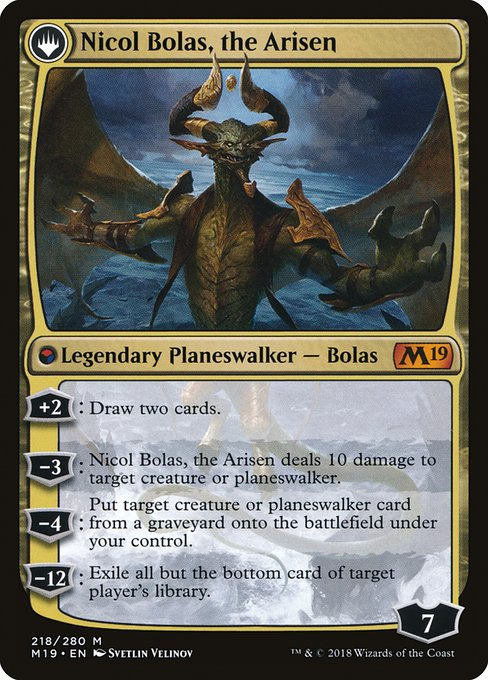
A planeswalker’s ability to just leave planes or areas just about whenever they want is also something we see addressed in the story of MTG.
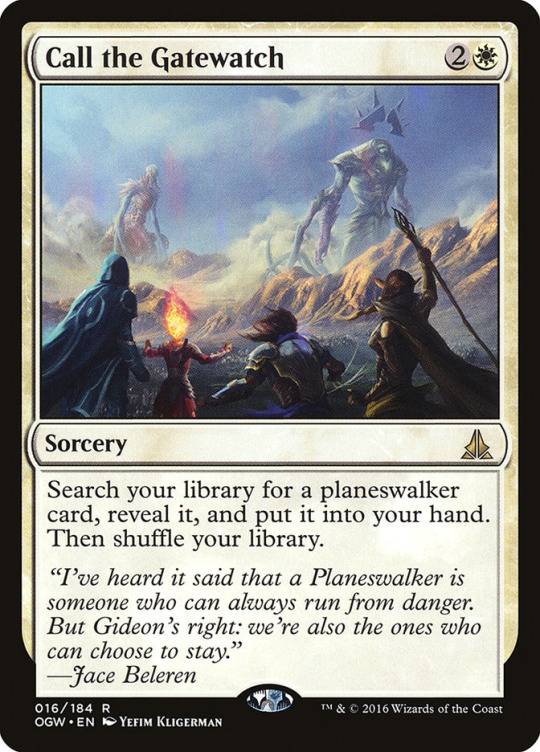
“I’ve heard it said that a Planeswalker is someone who can always run from danger. But Gideon’s right: we’re also the ones who can choose to stay.” —Jace Beleren
Planeswalkers have a level of choice and freedom that most other creatures do not have. Honestly, the artistic technique we see on planeswalker cards reminds me of how comic artists may play around with things like the panels by doing things like having characters reach outside the panels to show how powerful a character is, that a character is not bound by normal logic, and/or that the character/panel in question is just super important.
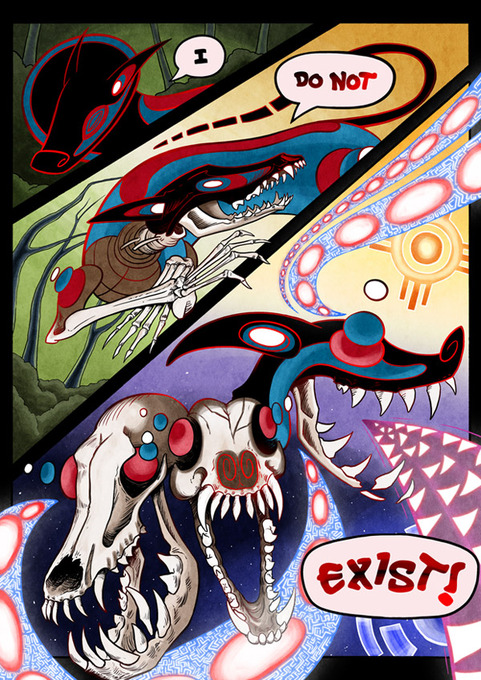
The panel above is from the Webcomic Gunnerkrigg Court by Tom Siddell from page 1068 (https://www.gunnerkrigg.com/?p=1068) and it depicts the character Coyote. I wish I could think of more strong examples (and feel free to leave your own). In this page we can see Coyote’s reality warping power emphasized as he begins to reach outside the frame with his hand in the second panel and then in the third panel he takes in a more abstract form as he freely spills out into the areas below and next to the panel. You could also argue that this shows that what we are usually seeing is actually not Coyote’s true/only form and that he is a being that is just on another level of existence. He is not bound by the same physics, rules, and laws that most other characters are.
Back to MTG though, I know some of you are inevitably going to say “Okay cool, but what about Marit Lage?” and my response to that is "Wow what a throwback…”

The rest of you are probably going to ask about the Eldrazi for the same reason.
Now, the Eldrazi aren’t Planeswalkers so despite their ability to travel from one plane to another they don’t use the exact same art techniques that planeswalkers do because they are telling a slightly different story. One thing some may notice about the Eldrazi is the fact that they fuck with the borders of the card. More specifically you can see the rest of their art near the border of the card and outside the rest of their art frames in the default printing.
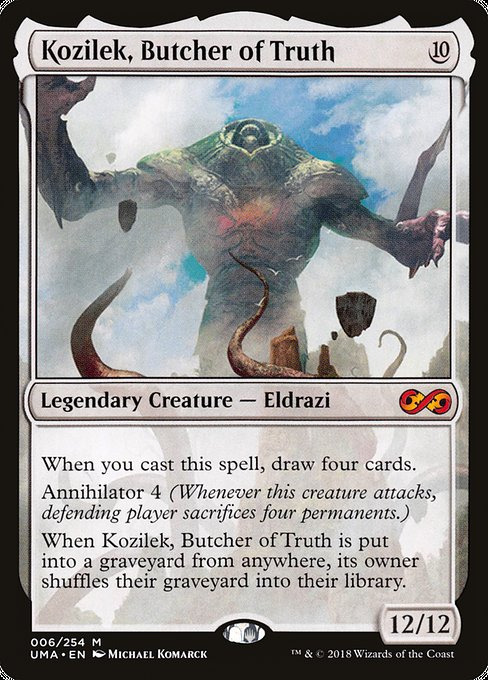

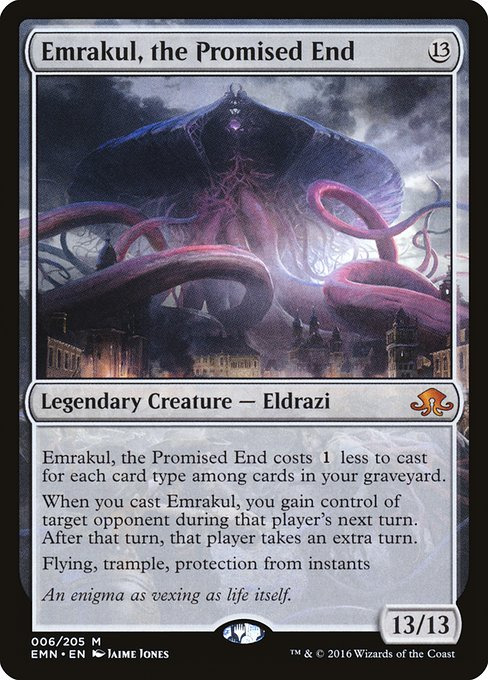
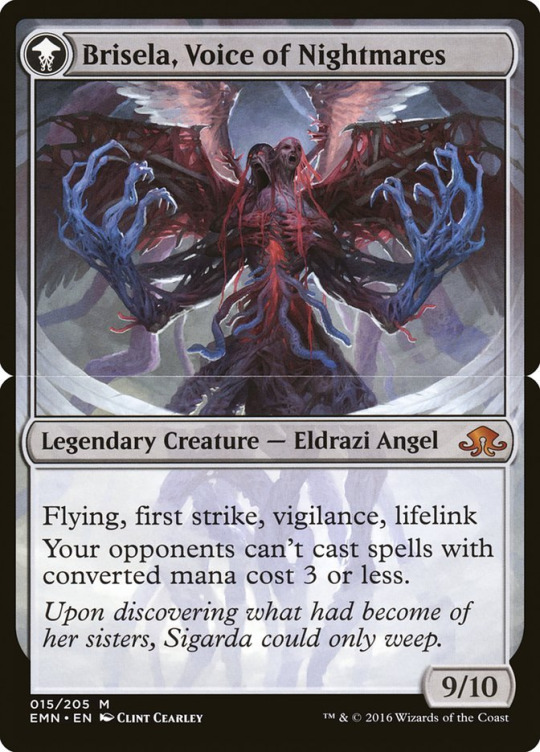
Not to mention that with a lot of them you can see the entirety of the art behind the various text boxes in general. This shows us that while, yes, the Eldrazi are similar to planeswalkers in that they are free to travel from plane to plane they are different in that they aren’t bound to our frame of reference of the symbolic frame of planes we are seeing. Unlike planeswalkers, the true body of the Eldrazi resides outside of any plane and within the Blind Eternities themselves. A fact that one could argue is kind of represented by the fact that there is more of the Eldrazi outside of the picture frame.
In essence, if you only look at the card’s art frame then you are not getting the full picture of their existence and their true form doesn’t even really fit into the scene they inhabit so we have to zoom all the way out and look at them from outside the moment/world/plane that they are currently inhabiting. This is also further emphasized with just how fucking massive the Eldrazi titans themselves are. They are so big that they don’t even completely fit into the card they are on despite having almost the entirety of the card to portray their form. Their physical form in of itself is not the Eldrazi’s true form and to look upon only its physical form, massive as they may be, does not create a complete picture of what they are. Additionally, their strange card art and borders just highlights them as unusual, important, eye-catching, or something you don’t see every day. Especially when you compare them to normal creatures.

The fact that the Eldrazi extend outside of where a Magic card’s art is normally contained could also reference their ability to travel from plane to plane. However, the way they do so is different from that of Planeswalkers. While planeswalkers are capable of crossing the borders of planes and stepping from one metaphorical scene to another Eldrazi just don’t have any borders, at least not in the same way a normal plane dwelling entity does. Planeswalkers jump from plane to plane but Eldrazi merely move in, out, and through the Blind Eternities to get to another plane. Even then, as mentioned earlier, it is not their true form that enters a plane as their true form still lies within the Blind Eternities themselves. So in essence the Eldrazi are just sort of “reaching” into planes they want to interact with.
I guess if I had to explain this in the simplest way possible I would say that the fact that planeswalkers almost always have bits of their body sticking out of the art frame is a representation of both their importance and the extra level of freedom and movement that comes with planeswalking. A freedom that normal creatures, spells, and other things don’t have access to.
Additionally, in the cases of instants, sorceries, and enchantments. planeswalkers usually seem unable to cast spells mid planeswalk (at least to my knowledge). Casting spells from the Blind Eternities if you're a planeswalker isn’t something that you can just do which would explain why these kinds of spells would still be more contained within their art frame even when they are being used by or associated with planeswalkers.
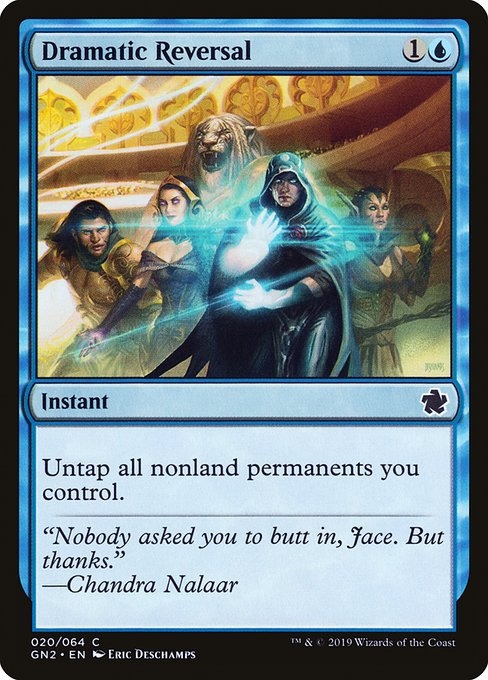
Then you have artifacts. While some artifacts can be brought to different planes by a planeswalker it is important to remember that artifacts are a way WAY broader and vague category than a lot of Magic players seem to assume. While artifacts can represent some types of inorganic material or technology, most of which a planeswalker could take with them when they planeswalk, they can also just represent inanimate objects. Which can often include things that are organic and thus cannot be taken off a plane via planeswalking.
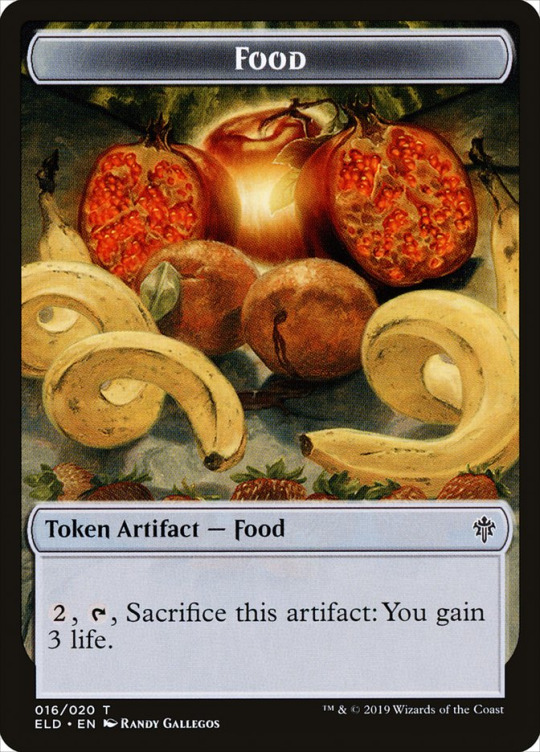
For example, most food we see is composed of organic material and thus attempting to planeswalk with them would cause them to be destroyed in the blind eternities. However, it’s more likely that artifacts not having the same border crossing art treatment as planeswalkers is simply connected to the fact that even artifact that can be safely carried when planeswalking do not necessarily have the ability to planeswalk on their own or by themselves and would thus need a planeswalker, or I guess an Omenpath as of March of the Machines, in order to leave a plane. Their ability to leave a plane is not intrinsic to them in the same way it is for planeswalkers.

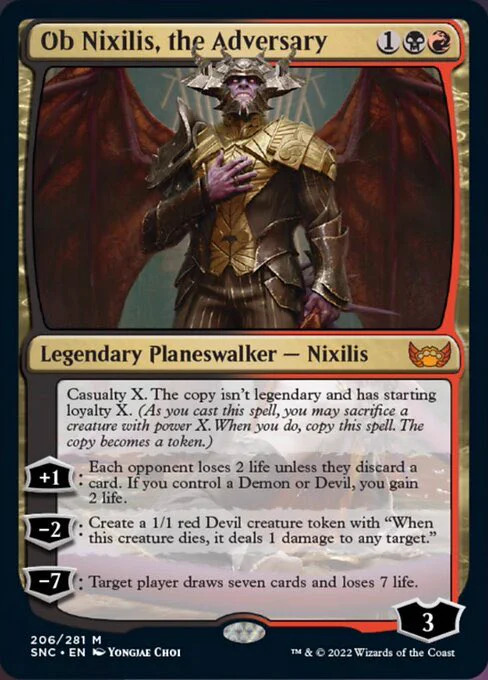

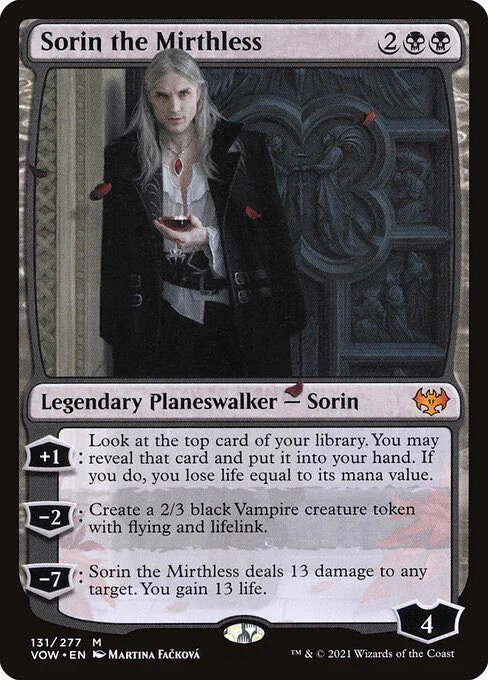
Meanwhile, the art of the Eldrazi and their associated cards along with how said art plays with the art frame tends to represent that while they aren’t planeswalkers they aren’t limited to a plane and the metaphorical frame that normal creatures are. Their influence extends from outside of our frame of reference and comprehension.

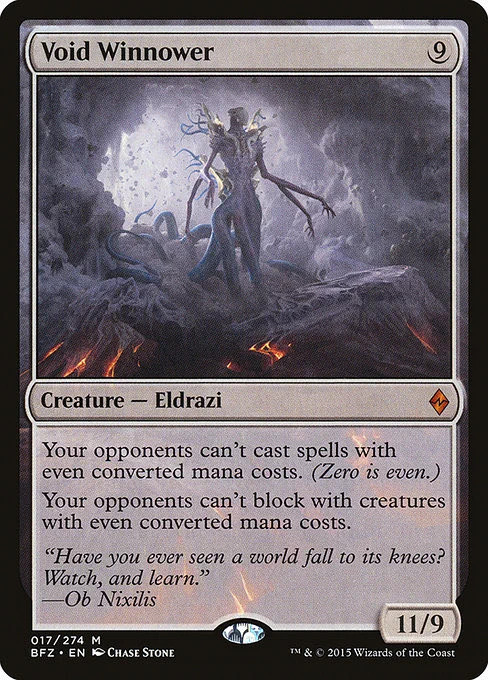
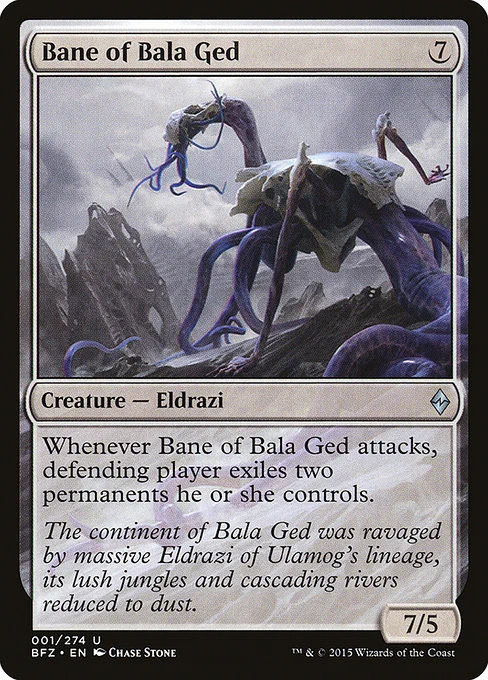
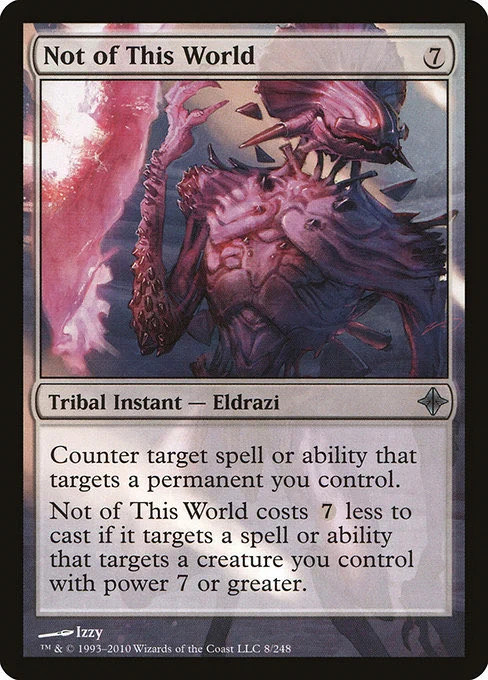
As I mentioned earlier we are only focusing on default card art and not alternative art, special editions, secret layers, etc. because they often have an incentive to break these rules in order to make more interesting art that would otherwise normally not make sense in a given set. However, even excluding these alts there are still exceptions. For example, Tibalt, Cosmic Imposter is a planeswalker card that depicts Tibalt sitting cleanly inside his frame.

On one hand I think it can be easily argued that this is simply due to his posture and position within the piece. But that then raises the question why would the art be done this way then? If we actually take a second to put ourselves in the shoes of an artist or art director who wants to keep the motif of planeswalkers going one could easily do so by simply raising Tibalt’s position higher so that his arm barely sticks out of the frame, outstretching his right arm so that his fingers stick out a little bit, or even just making one of the many coins raining down on him spill out of the bottom of the frame ever so slightly. Not to mention that you can still see a bit of his art behind the textbox like every other planeswalker so why would you stop there when it comes to planeswalkers. These factors don’t rule out the possibility that it was a coincidence but make me lean more towards the idea that this might have actually been intentional on the part of one or more parties. I think a possible answer lies in Kaldheim’s story in which Tibalt disguises himself as one of the plane’s inhabitants and gods, Valki, God of Lies (which I have to admit I find a little funny because if I was going to disguise myself as someone choosing the one guy who’s famously known for being untrustworthy, and a liar is quite the move).

From this perspective we could argue that the reason Tibalt, Cosmic Imposter, sits inside his frame is because it is supposed to mirror Valki in the sense that Tibalt is disguising himself as one of the normal inhabitants of Kaldheim and would thus appear to be on their level from a sort of metaphysically metaphorical perspective. So in this way the art of Tibalt on this card shows a metaphorical connection to his disguise of Valki.
Thanks for reading, or skimming, this article. What’s your favorite planeswalker art that is not an alternative art and why? Also, I do have more articles if you're interested such as pieces discussing the Color Pie in relation to Kamigawa, Innistrad’s factions, and longer form pieces discussing the Color Pie in general, such as White and Blue. I hope to see you later.
You can check out the list of all the articles I’ve written so far with this link: https://docs.google.com/document/d/1Ita3Eh8P2SdNtF9eCorKbhchtLXrrKJheK5_6OpRFSs/edit
3 notes
·
View notes
Note
re: your grumpy friend who’s annoying playing mtg
I’m not as socially deficient as this guy, but I get some of where he’s coming from. While I do like to play competitively or recreationally, things like storytelling, art, lore, the feel of the world, etc. are a big part of what attracts me to one game or another, one expansion or another, etc. I also really don’t care about limited formats or draft formats, for the same reason. Deck cohesion and theming is a big part of what makes card games fun to me, so I’ve only ever really like tribal sets in limited.
I’m not as big of a crybaby about people playing to win as I used to be, or as much as he is, but idk how old he is. I was obnoxious as a kid.
ANYWAY, actual advice:
If you guys really want to keep him as a friend, have you considered just playing something else? It seems like he’d have a lot more fun playing a collaborative game, or a ttrpg, or doing a different activity with more of a role-playing creative aspect
not trying to tell you how to live your life, but I can see how a guy like that would find a competitive game very frustrating, I almost exclusively play single player games and watch movies these days, or play commander precon v. precon as a very casual party game.
league of legends was like, life-ruining frustrating for me, as much as I got invested in the world and its characters, the actual gameplay experience was just kinda ass
oh believe me, i also get where he's coming from, i'm not saying that his style of play and what he finds rewarding in magic is wrong or lesser than mine, and if my original post implied that, that absolutely was not my intent. i get it from a parallel sense; he enjoys constructing stories with his decks and i enjoy constructing rube goldberg machines with mine. both are correct ways of playing magic
i also feel i should clarify the pod's "competitiveness": we all play kitchen table. my favorite 60 card deck of mine to play is a madness deck that costs about $6. the most expensive deck ever to hit our table was around $70 and it was HIS eldrazi deck. it's never been a rout either, he has the second highest winning record in the pod. we keep a tally - he wins more than he loses. lol i have the worst record in the pod by far, and it is a bummer i very much get it, but i don't scream obscenities at my friends when i lose
and we DO play ttrpgs - half of my mtg pod is also half of my tt group (it's like a venn diagram of my nerd friends). i've invited him to play multiple times, but he only wants to play rogue trader or 5e and i'm currently running a pbta campaign. i've encouraged him to run his own rogue trader campaign - i've been a DM for over a decade, i LOVE opportunities to be a player again - but he's never taken me up on it. our magic nights are sort of... open? if that makes sense? we post times and who's hosting in the discord, whoever wants to show up shows up and we play. no one's forcing him to play magic with us, he's making the conscious choice to come to magic nights
what bothers me is that for him, gameplay is not a two-way street. if he takes out something on my board, that's "strategy." if i return the favor - because on what planet am i going to let Krenko, Mob Boss stay on a battlefield already covered in goblin tokens if i have a Murder in hand - i'm "targeting him." he behaves as if his opponent is supposed to be his audience, not a participating player in a game
also, if this puts anything into perspective, he's almost 40
#voxbox#mtg#i also should clarify that he's been one of my best friends for almost 18 years. he used to handle these kinds of things a lot better#he's always seen himself as the main character in everything - we met on a high-fantasy-lotr-knock-off RP server in the early#aughts and he was like that 'i am upset when we are not about me' bird tweet but he's gotten so much worse lately#we've tried asking outside of mtg nights if anything's going on or if he's okay and he just says 'work's gotten stressful'#i get that. my job is also very stressful. but i don't lurch to my feet shouting 'don't fuck me off or you'll regret it' because someone#Murdered the ONLY COPY OF KRENKO I PUT IN MY DECK#which is what i mean by 'put in multiple win conditions'. again i am not a vorthos player so this is a genuine question but do thematic#and/or story decks tend to be singleton? because his are. he's got a kindred goblin deck he's put a lot of time into and it only has one#copy of krenko mob boss in it. which is his win condition#he WANTS to win. he is competitive. but he wants to win even with his story decks and acts like it's a personal attack when he doesn't#...i hadn't realized how bad it's gotten until typing all of this out
0 notes
Text
Ring of Gix is one of the few reserved list cards that actually has a gold rarity symbol. As information became more widespread and the internet became a more accessible tool in the home, there was less reason to hide the rarity of each card. Island was a rare in one of the first sets and that was meant to obscure rarity. Who would have guessed that a basic land would be a rare? Personally, I do not think that is healthy for the game. Making basic lands hard to get in order to confuse people about how rare each card was was not a winning formula. Thus, the era of hidden rarities ended and the urza block was the first block to have cards clearly labeled. Commons typically had a black symbol. Uncommon were silver and rares were gold. Even today, we still use these same colors to denote rarity. Mythic rare was eventually added but urza's block represented a shift in the game. All rares were defined. Everyone knew what cards were in lower supply which helped to contribute to the rise of the secondary market. Cards were not merely expensive because they were powerful but because the company defined them as scarce and rare. I like the transparency of knowing immediately if a card is rare. So is ring of gix a playable reserved list card? First, this card is outclassed by icy manipulator. Ring of Gix has the same exact ability but costs one less mana to cast. You may think this is an upgrade but this card also has an echo cost so you will actually need to pay 6 mana to keep the ring of gix around while icy manipulator only requires 4 mana and no upkeep. Icy manipulator is superior with the exception being if you only needed this effect for one turn. However if you only needed this ability one time then there are cheaper cards to accomplish that task. It looks like ring of gix was meant to be a weaker callback to icy manipulator as that was considered a very obnoxious card in old school mtg. Having to pay an echo cost really helps balance the effect. Yet, in our modern era, icy manipulator has experienced power creep. It was reprinted in dominaria and did not see any competitive play. If icy manipulator is no longer good enough then what does that say about ring of gix? Currently, ring of gix sees play in 0 percent of decks on edhrec. That is a shame because ring of gix can still function as a flavor card. It is a colorless artifact so you can play in anything. How about a gix flavored deck? Gix is a decent commander and tapping my opponents creatures will help me deal damage and draw. You might also play this in sauron decks. Sauron is lord of the rings and I can see a Sauron deck that uses a ton of cards with ring in the art or title. Hylda of the icy crown also might a continuous way to tap down creatures turn after turn. Overall, even when ring of gix first released, it was already outperformed. You don't always have to play an optimized deck though. Sometimes a nice flavor deck centered around a praetor is exactly what you need.
#gix#ring of gix#magic the gathering#magic the card game#youtube#commander legends#commander#mtg#blogatog#arena#mark rosewater#reserve list#tolarian community college#alpha investments#magic the gathering arena#magic arena#magic card game#magic#mtg arena#mtgstocks#mtg zendikar#mtgo#mtg commander#mtg art#flavor#phyrexia#new phyrexia#yawgmoth
1 note
·
View note
Text
MTG: Rotating The Roots In My Mind
A new set has come out, Standard has changed, and with it a whole host of new cards that may or may not matter for my beloved Insidious Roots deck.
What am I gunna do?
The notes for this article wound up over a thousand words. I just put them under the fold. It’s hard to work out what I’m gunna do. Here are my thoughts on it, regardless of how good or how meaningful it is as a thought process.
Here’s the lesson up front; three year long standard, with our current landscape has created a niche benefit for me, as a free-to-play Magic: The Gathering Arena player. Decks are changed, a little, with each new release, rather than being overhauled and overthrown by each change. When Insidious Roots rotates out, I will have to change the deck, but at exactly this point, it’s fine. My mono-red deck is fine, and when individual cards go, I can replace them with newer, similar cards in newer sets.
Here’s the deck, before making any (serious) changes from Outlaws of Thunder Junction. And this deck, and revising this deck, has overwhelmed me. Not because there’s no changes worth making – but because my demands are competing with one another. I want this deck to have as many creatures in it as possible. Ideally, the deck would have nothing but creatures, and the roots, but that’s silly and we know we’re not going to get that. I also wish I had 24 lands, but I’m already getting distracted.
This deck has not really changed with the release of Outlaws of Thunder Junction. It’s not because it can’t be changed. It’s not because changes are not desireable. I know I have wants. But The problem comes considering what to swap in and out and how it changes the composition of a deck that I know full well is not that good and how those changes relate to the deck as it currently is.
A thing I honestly wanted to do for this article and wound up being untenable was to create an example spreadsheet you could click through to see each card and how it related to what else in the deck and what needs it addressed. It’s because there are threads of how these cards interact that meshes together in a complicated set of tensions.
Here’s an example; right now, the thing I most keenly feel is wrong or bad with this deck is the power of Pile On. Pile On is a surveil removal spell, it’s got convoke so it can fire off when I’m tapped low, and it kills things mostly unequivocally. Also, crucially, I had it, because I had made a black-green alchemy deck when I got started. The surveil is good! I want sources of surveil wherever I can get them because they’re the way to actually dig through the deck trying to find the Insidious Roots. On the other hand, early on it doesn’t work to defend me, and it’s only useful if I have a board presence. There are other removal spells that could do the same job, slightly better… kinda. Bitter Ordeal could be used to chuck things into the yard, and is very effective at just killing things early in the game. But even then, what about Assassin's Trophy? That does almost all the same things and it hits artifacts and enchantments, battles and planeswalkers too, there’s a lot it can do.
And like, Assassin’s Trophy presents an alternative to Outland Liberator. That card is in the big collection of threads a loose end. Because it can sometimes enter the battlefield as a 3/3 instead of a 2/2, it’s possible that it fails to work with the Snarling Gorehound and means there’s one fewer surveil. What’s more, that’s not under your control very easily, which means sometimes, an opponent can make the Outland Liberator in my hand into a ‘better’ card I can’t use in all the ways I want because what’s most important to me is getting that surveil.
I’ve also used Annihilating Glare, but it being sorcery speed makes it less desireable. On the other hand it can eat a food token (if I’m using Restless Cottage) or an Incubator token (if I’m using Ichor Drinker).
This is all in the space of the question of ‘hey, is Pile On the best removal spell in this space?’
There are also unused opportunities. Check out Intrepid Paleontologist. That can let me reuse dinosaur cards. Know how many useful cards there are that are dinosaurs? Not many, but also, crucially, not none – there’s Thrashing Brontodon as a possible artifact or enchantment removal spell, and there’s also the landcyclers Nurturing Bristleback and Rampaging Spiketail. But I don’t need those unless I’m bulking the deck up and making it able to cast big, expensive spells later. Is giving up on the potential late game juice out of the paleontologist okay?
(Yes, it is okay, I have made that choice).
Then there are the cards that present interesting opportunities from Outlaws of Thunder Junction, if – and it’s a big if! – I can provide them their needs. Stubborn Burrowfiend can do a job of a Souls of the Lost… if I can saddle it consistently, and that means wanting something that probably works with the saddling? Forsaken Miner could jump out of the yard consistently for cheap, if I can commit a crime. Kaervek the Punisher, god damn, that could be a black engine if I was committing crimes regularly. Rise of the Varmints could be a budget version of the Souls of the Lost, and Desperate Bloodseeker Has an overlap with the Undead Butler, and… and…
None of these pieces fit in tightly. I don’t have a crime engine.
Of course, Unlicensed Hearse is a crime engine. It lets me exile cards from the yard. It can trigger crimes and even be a big threat, too. But that’s only useful if I’m making any of these other changes, and all of this is looking at a deck that’s already running fewer lands than I think I should be running!
I can tell you things I wish I had. I wish I had Fell Stinger but as like, a 1/3 for 2. I wish I had Honest Rutstein but with a power of 2 and maybe something else to go with it. I wish I had Deathbonnet Sprout but less slow. I kinda want Old Stickfingers, just as is. I want my Propagator Primordium from Alchemy!
I swear, this started as just one example.
Check it out on PRESS.exe to see it with images and links!
0 notes
Text
How to Actually Play Magic: The Gathering
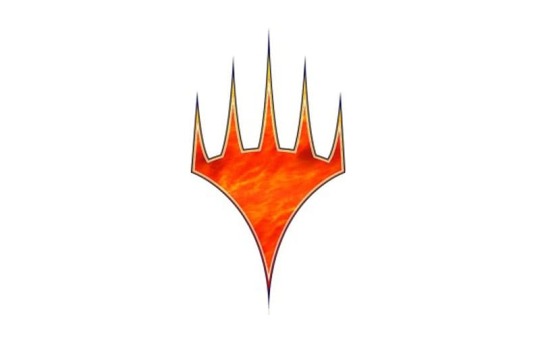
Magic: The Gathering (MTG, or just Magic) is the first and one of the most popular trading card games in the world. Described as the chess of card games, you can go as complex as you want (even make a computer) or have as much fun as you want, diving into the multitudes of worlds, creatures, and characters to express yourself.
But first you need to know how to play.
Lots of guides tend to be overly simplistic, so here I’ll try to go really in-depth in the rules while still maintaining an introductory tone. I will also try to provide as many pictures of relevant cards as possible to expose you to the vast array of effects cards may have, and how they interact with what I’m currently discussing.
1. The Colors of Magic

The most defining part of Magic are the five different colors. Each has its own flavor, playstyle, advantages, and disadvantages. You can combine different colors in your deck to have access to interesting combos and to balance out your deck’s weaknesses. Different color combinations also have their own specific flavor, often embodied by groups such as the guilds of Ravnica.
White: This is the color of unity, healing, and order. Cards in this color will often gain you life, protect your creatures from damage, tax or outright prevent your opponents from doing tricky things, and make armies of small creatures that together make mighty fighting forces. It is also associated with artifacts, enchantments, and exiling.
By the way, I will be defining Magic terms as they come up, like so.
Token: A representation of a creature, artifact, or something else. You can use it like a card while it exists, but it will vanish when it leaves the battlefield. (the rest of these terms will come up soon.)
Exile: Originally called “removed from the game”, exile is a zone that is inaccessible to most cards. It makes sure your opponents’ creatures go away forever. Sometimes, creatures go to exile and come right back to get extra enter-the-battlefield effects, known as blinking.
If you see something that isn’t immediately defined, just keep it in mind. Chances are I’ll cover it in a later chapter.
Blue: This color is related to knowledge, water, and the cold. You’ll get to draw lots of cards, but your creatures will be lacking. Instead, you will have access to powerful spells that bounce, freeze, or steal your opponents’ creatures and even give you extra turns. Quelch your opponents’ attempts with counterspells. It also has affinity for artifacts.
Black: This color represents death, disease, and ambition. Full of evil kill and discard spells, you will have access to your own army of zombies, vampires, and demons. You will also be able to do powerful things, but often at the cost of cards, creatures, or even your own health. In the words of Dark Confidant, “Greatness, at any cost.”
Red: This is the color of passion, fire, and explosive power. Many of the direct damage spells, including the iconic Lightning Bolt, are Red, as well as aggressive, fast creatures and multiple combats. You will have an extreme upper hand in your first few turns, but will quickly run out of gas if you don’t use another color to keep up on card draw. Red also brings with it mighty dragons and world-morphing chaotic effects.
Green: The color of nature, Green is similar to white in its abilities to heal, create tokens, and destroy artifacts and enchantments. However, Green has a wild side and is full of giant beasts, swarms of bugs, and rapid evolutions. It also brings out lands quickly and makes tons of mana.
2. Dissecting a Card

Sidisi is a popular character that hales from the plane of Tarkir. She’ll be helping us as a prime example of what a card looks like. There’s a lot to take in, but we’ll start from the top and work our way down.
First is the border (yes, from the very top!). It seems silly, but there are actually a few different borders that mean different things. A vast majority of cards have the regular black border. You may also see cards with white borders - these tend to be older cards, but they’re just as good as the black bordered ones. Silver borders come from the Un-sets, a series of joke sets full of wacky mechanics and inside jokes. None of these cards are tournament legal, but you’re free to have fun with them with your friends. Gold-bordered cards will also have a different back, and were printed as a part of tournament-winning decks back in the day. These are not tournament legal, but since they are often cheaper than their “real card” counterparts, people will use them in casual decks.

Next is the name. “Sidisi, Brood Tyrant” is the full, English name of this card. Each deck can only have up to 4 copies of any single card (there are very important exceptions to this I will cover in the next chapter). There are also a few cards which specifically reference others by name.
To the right of that is the mana cost. In this case, we need to use one black mana, one green mana, one blue mana (each represented by their respective symbol) and one mana which can be of any color, or even colorless, represented by the 1 in the circle. We’ll find out how to get mana in the next chapter as well. As a side note, many cards will consider the mana value (formerly, converted mana cost), which is just the total cost of the card as a number. For Sidisi, it’s four.
Beneath that is the art.

Arguably the most important part of any card, Magic’s art is what really sets it apart from other games. People fall in love with specific cards for their dramatic poses, mighty beings, and stunning vistas. The art brings character to every card, and ties flavor and function beautifully. This is the best way to express yourself, and find what you really like about Magic.

Next is a thin bar called the typeline. This will tell you first what type of card it is - either a land, creature, artifact, enchantment, planeswalker, instant, sorcery, or tribal (or some combination!), which dictate how you use the card, and what other cards interact with it. Card types can be divided into permanent, which go on the battlefield once played, and nonpermanent, which you play for a single effect and immediately go to your graveyard. There are also some supertypes. Sidisi herself is Legendary, meaning she represents a specific character from Magic lore. This also means you can only have a single copy of her on the battlefield at any one moment; if you somehow get another, you’ll have to sacrifice one. Basic is another important supertype we’ll cover soon.
On the other side of the hyphen is the subtype - this is almost exclusively used for creatures to tell you what tribes they belong to. Sidisi herself is a Naga and a Shaman, and will thus interact with cards that care about that (these are often called tribal effects; for example, “Elves you control get +1/+1″). From Trilobites to Trolls, the creatures of magic are a diverse crowd.
Finally comes the set symbol, that strange orange shield thingy to the right. This tells you two things: the set the card comes from, and the rarity. This specific symbol represents the set Khans of Tarkir, so booster packs from that set may contain Sidisi. Rarity comes in 5 different colors.

Black: Common (Simple, often weak)
Silver: Uncommon (May have cool mechanics)
Gold: Rare (More powerful and complex)
Orange: Mythic Rare (The most powerful and complex)
Purple: Special (This is only used in situations such as Time Spiral, where they reprinted cards in the old border)
The rarity often (but not necessarily) corresponds to power level. It’s better to think of it as a ranking of design complexity. Newer Rares and Mythics will also have that shiny, elliptical sticker near the bottom, which simply guarantees the authenticity of the card.

The bottom half of the card is dominated by the text box. This will tell you the effects and abilities of the card. Sidisi has two abilities: one that triggers whenever she enters the battlefield or attacks, and one that triggers whenever a creature card is put into the graveyard from your library (on modern cards, this is called milling). We will go over abilities later.
Notice how Sidisi aligns with her colors. As a Naga, she is Green. Her zombie tokens are characteristic of Black, and tokens are generally Green as well. Milling is a Blue ability, and putting creatures in the graveyard to bring back to life is definitely Black.
The text box is also home to flavor text, the italicized text beneath the rules. This will often be a little blurb or quote relating to the flavor of the card. Consider it an extension of the art.
Creatures will also have that rectangle to the bottom right, called the Power and Toughness. The first number is the power (how hard it punches) and the second is the toughness (how hard of a punch it can take). This is relevant for combat and we will cover it extensively later.
Finally come all those funny symbols at the very bottom. This will include the collector’s number (199/269), the set (KTK = Khans of Tarkir), the artist (Karl Kopinski) and the copyright.
3. Lands
Lands are by far the most important component of your deck. They are what generate the mana you need to cast your spells, and dictate the colors of spells you can play.
You can play one land per turn - just plop it from your hand onto the battlefield. They have no mana cost, and thus the top right is blank.
The Basic land is the prime exception to the four-card limit, as you can have as many as you want in your deck. The Basic supertype also interacts with several cards, such as ones which let you get more from your deck onto the battlefield.
The 6 basic lands are Plains (white), Island (blue), Swamp (black), Mountain (red), Forest (green), and Wastes (colorless, only used in decks such as Eldrazi Tron, and are often not included).

This cycle comes from Lorwyn, a set based in Gaelic mythology.
All Basic lands come with the implied rules text that they can tap to create one mana of their respective color, and as such will often have the cinematic mana symbol instead.
Tap: A common cost on a permanent to activate an ability. Turn the card sideways to tap it. It will stay tapped until your next turn, when it will untap during your untap phase (more on that later). A tapped card can’t be tapped again, and a tapped creature can’t block.
Some lands, especially those that can make different colors, will enter the battlefield tapped, so you’ll have to wait an extra turn to use them. Other lands might only create colorless mana (represented by a number on older cards and a diamond on newer cards), so they’re less useful for casting spells, but will have interesting abilities, such as:

This Mutavault can turn into a creature for just 1 mana, which you can use to attack and block with. (Pop quiz: see if you can recognize each part of the card!) There are dozens more examples that do everything from draw you cards to destroy your opponents’ pesky lands.
But what exactly does it mean to create a mana? Well, really, it gets added to your mana pool, as you may have noticed on the Mutavault. This is an arbitrary place where all your mana goes so that you can spend it. This isn’t often relevant, because you’ll mostly tap your lands while casting spells and the mana will immediately be used, but there are a few scenarios where it might be useful. For example, someone targets your land to destroy it because they don’t want you to have the mana open to kill something they’ll play next. Just tap your land to keep a mana “floating”. However, all the mana in your pool will automatically drain out each time you change phases (more on those later).
Tapping lands for mana is an ability, but since it’s a mana ability, it won’t use the stack, so you can use them just about whenever. More on the stack later as well.
Most decks will be around one-third lands, with more or less depending on how low the average cost of cards you have are. The less colors you run, the less cards you have at your disposal, but the more flexible your mana base can be - more colors often use lands that enter tapped and are inconsistent at drawing the colors they need.
Have fun experimenting with your mana base, especially in casual formats. In more competitive formats, lands are actually the most expensive cards! The top lands are called the shocklands, fetchlands, and original dual lands - the last of which are several hundred dollars each.
4. Permanents
Besides lands, just about every other card you play is considered a spell when you cast it (you’ll see this on cards such as Counterspell). However, for the sake of clarity, I’ll be using “Permanent” to refer to anything that goes directly on the battlefield once it resolves and “Spell” to refer to single-use cards.
Of the card types mentioned above, permanents include lands (which we just covered), creatures, artifacts, enchantments, and the mighty planeswalkers. I’ll include a visual example of each as we go.
Creatures are your basic way of winning the game. They can attack your opponent to take down their life total, but might also have interesting abilities that make them more valuable as repeatable spells than combatants.

Incubation druid is a great example of both: she starts off as an additional land, giving you more mana quicker to play your other cards. With 0 power, she’s useless as an attacker. However, her Adapt ability lets her grow into a formidable 3/5, so you can attack and block with her much more effectively later in the game. Notice the curved arrow symbol that represents tapping.
+1/+1 Counter: This is a permanent buff to your creature, giving it an additional power and toughness each. Counters in general can come in many forms: -1/-1 counters are self-explanatory, but ability counters such as a Flying counter give your creature a new keyword. Other counters, such as Lore and Filibuster, keep track of certain things for you. Always bring a few dice with you to every game, as you’re sure to want to track some sort of counter.
Creatures enter the battlefield with summoning sickness, which means they can’t attack or use any ability that requires them to tap until your next turn. Creatures also get summoning sick when they change control. A creature with Haste, a keyword ability, lets you ignore this, and is often found on red creatures.
Artifacts, lore wise, are artificial, sterile creations of wizardry, and as such, almost never correspond to a color. They may imitate the effects of a certain color, but to prevent other colors from having easy access to it, they will often be overcosted. A common type of artifact is colloquially known as the mana rock, as it generates mana. There are many cards that interact and enhance artifacts.

Hedron Archive is a typical mana rock, costing four mana of any color and boosting your mana generation ability by two. Later in the game, if you already have more than enough lands, you can cash it in for two mana to draw some more cards. Notice the distinct metallic border.
Artifacts often combine with Creatures to form Artifact Creatures, or less commonly with Lands to create Artifact Lands.
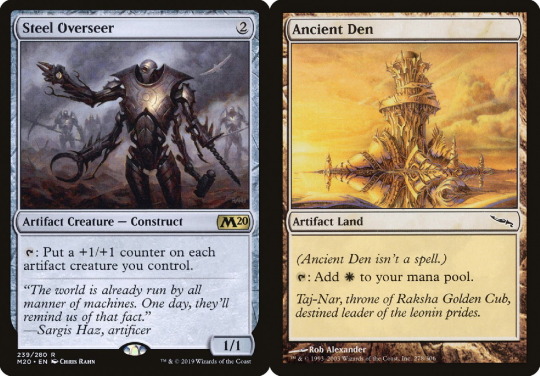
Artifacts can also come on the form of Equipment, which will give an effect when equipped to a creature. This often comes in the form of a buff to its power and toughness, but can also include adding keywords and other cool abilities. You’ll need to equip it by paying a cost, and can pass equipment around between any of your creatures. This can result in some funny mental images, such as a cat wearing a suit of armor and wielding three swords!

Enchantments are similar to artifacts in that they sit on the battlefield and have an effect, but they will have color. Also, Green and White excel at “cleansing” both by destroying them, but Red is only good at blowing up artifacts - after all, an ogre with a mace can smash a rock, but not a mystical spell.
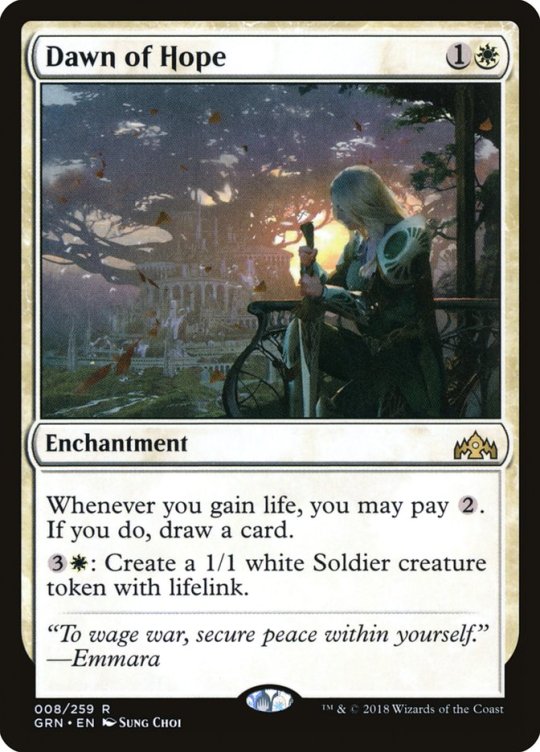
Some enchantments have the subtype Aura. This means you cast them targeting a specific permanent, and they will enter the battlefield attached to that permanent like a piece of Equipment. These, however, can’t be moved around, and will fall off and go to the graveyard if the thing they enchant ever leaves the battlefield. Auras will often buff creatures, but can also subdue permanents or boost a land’s mana production.

Planeswalkers are the newest and arguably the most powerful of the permanents. They represent the primary characters of MTG lore, beings who have incredible magical prowess and can teleport from plane to plane. They are (as of yet) all legendary, and thus you can only have one of each at a time on the battlefield.
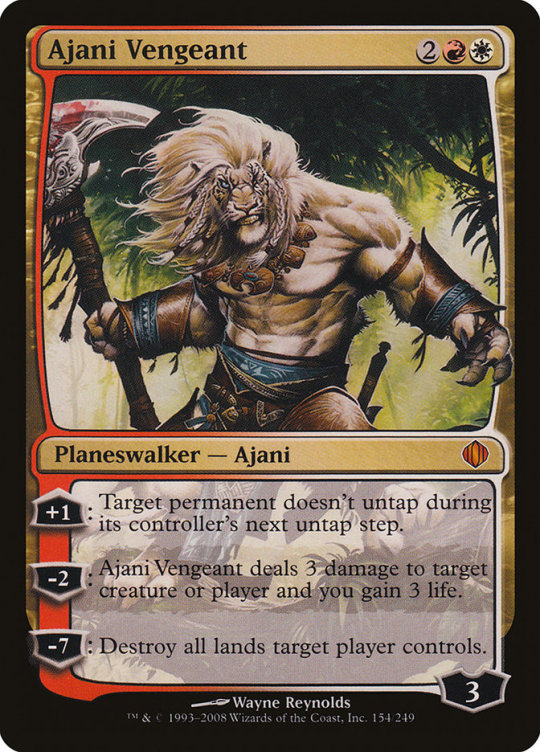
They look pretty weird, don’t they? Instead of a power and toughness, they have a loyalty in the bottom right. Each planeswalker will enter the battlefield with that many loyalty counters on it. You can activate one of its abilities on each of your turns by adding or subtracting the indicated loyalty. Once a planeswalker is at zero, it dies and goes to the graveyard (or rather, gets fed up with your mishandling and teleports away, as per loyalty flavor). Planeswalkers can also be killed by spells that specifically target them, when they’re dealt damage, or when they’re attacked by creatures. Their last ability is often incredibly powerful, and is called an “ultimate”. Newer planeswalkers sometimes also have static abilities.
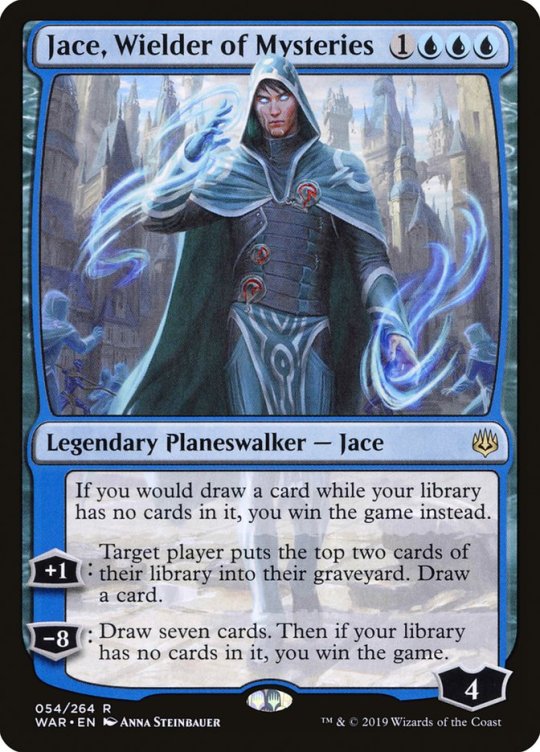
Planeswalkers are not creatures, and can’t attack or block. That being said, there are some planeswalkers that can turn into creatures.
Permanents are very useful, as they stick around and provide value turn after turn. Many strategies revolve around certain tribes, or using artifacts. Creatures are the main way to get damage through to your opponent to win the game. And planeswalkers have powerful abilities, requiring an answer from your opponent to stay in the game.
5. Spells
As stated above, all nonland cards are technically spells when cast, but here we will talk specifically about Instants and Sorceries. We will also define timing, as instant- and sorcery- speed is something we will discuss often when looking at casting spells, activating abilities, and using the stack.
Sorceries are your basic single-use card. Pay their cost, they’ll resolve, and you’ll get their effect once before they go to the graveyard.

Something I haven’t brought up yet is when you can play cards. We’ll go over the turn structure more in depth, but for now, know there’s a beginning step, a main phase, a combat phase, and a second main phase. You can play any of the previously mentioned cards, including sorceries, and activate planeswalker abilities, whenever it’s your main phase and the stack is empty.
The Stack: Whenever you cast a spell or activate a non-mana ability, or a triggered ability triggers, it will go on the stack. Things on the stack resolve last-in, first-out.
Instants are just like sorceries, but you can cast them at any time you have priority. This means they can go on the stack above other spells, which allows them to interact with other spells. Activated abilities can also be activated whenever, except for planeswalker abilities and those which specify otherwise.
Priority: When you have priority, you will have an opportunity to cast spells, play lands, and activate abilities. Everyone gets priority every phase, and it starts with the active player (whoever’s turn it is) and is passed around in turn order.
Whenever something goes on the stack, priority is passed around as well. Once each player has passed priority, it resolves and priority is passed once again for the next thing.
You can hold priority to cast multiple spells in a row.
Here’s a quick example to see how spells, abilities, and priority all interact on the stack:
Johnny and Timmy are playing each other, and it’s Timmy’s main phase. Johnny has a 0/2 Incubation Druid.
Timmy plays a Bala Ged Scorpion, which goes on the stack. Priority is passed around and it resolves. Its triggered ability goes on the stack, and Timmy targets Johnny’s Incubation Druid, since its power is 0, less than 1.
Since the ability is on the stack, Timmy gets priority and passes it to Johnny. In response, Johnny casts Burst of Strength, maintains priority, and casts a second Burst of Strength. Now priority passes between them for both, and they both resolve. Incubation Druid is now a 2/4.
Priority passes for Bala Ged Scorpion’s ability, but since the Incubation Druid now has more than 1 power, the ability does nothing and fizzles.
Fizzle: A spell whose target is no longer legal does nothing when it resolves. This is colloquially called fizzling.
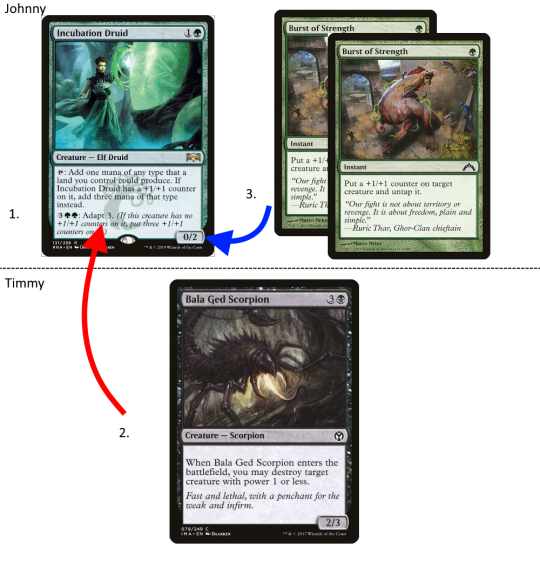
Assuming he had the mana for it, Johnny could also have activated Incubation Druid’s Adapt ability in response to the Bala Ged Scorpion, making it a 3/5 and also letting it survive.
There are lots of cool things you can do with the stack, such as making slick plays to foil your opponents’ spells or to copy big spells for massive value.
Some permanent cards have Flash. This is a keyword ability that lets you play the card as if it was an instant. Teferi, Mage of Zhalfir is the quintessential Flash card, as it also gives your other creatures flash and prevents your opponents from playing at instant speed.

6. Where are We?
I’ve been throwing around terms such as Graveyard and Battlefield, so what exactly do these mean? Well, these are all zones. We’ve already looked at one zone - Exile. The Stack is also a zone.
A zone is a place where cards can exist. They may have abilities that work while in that zone, most often on the battlefield. Public zones are where all the cards are known. This includes the Battlefield, the Graveyard, and Exile.
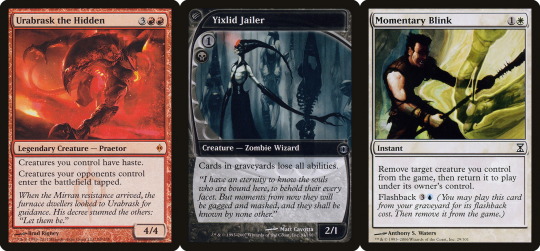
Urabrask’s ability only works while he’s on the battlefield, and only creatures you control on the battlefield would get haste - after all, those are the only ones who can use it, anyways. Yixlid Jailer takes away abilities from cards in graveyards, so Momentary Blink would not have Flashback while it’s there. Momentary Blink also exiles a creature (using the old wording of “removed from the game”) and brings it back, known as flickering.

Private zones are anywhere where cards are not public information. This includes your hand and your library. Thoughtseize, and other similar hand disruption spells, let you take a peek at what your opponent has. Loads of cards like Armillary Sphere let you search your library for cards. Others may reveal the top card of your library, or let you look at the top few.
It’s also possible to have “hidden” cards in public zones. Willbender feature the Morph mechanic, which lets you cast it face-down as a 2/2 creature. This means your opponent won’t know what it is until you turn it face up, but you will. Other effects might put cards face-down in exile, where you could cast them.
Whenever a card changes zones, it becomes a new “object”. That means all counters, equipment, and auras fall off, and it is no longer being targeted by anything that was targeting it before. A classic use of this rule is flickering a creature being targeted by a kill spell - even though it comes back to the battlefield, it is a new object and is thus no longer being targeted by the kill spell. The spell will fizzle and your creature will be safe.
7. Starting the Game
Ok. So you’ve got a basic understanding of all the cards and the different locations. How do you get started actually playing?
There are lots of ways to play the game, but I’ll start out with the most common: a 1v1, best of 3 duel. This will also get a little bit into deckbuilding, but there’s a lot more on that later.
Most 1v1 decks will be 60 cards. In fact, this is a lower limit, and you can have as many cards as you want, but it’s convention to stay at 60 cards to maintain consistency. In a best of 3 match, you will also have a sideboard - 15 or less cards that may target specific strategies such as graveyard decks or artifact decks. After your first game and seeing what your opponent is playing, you’ll be able to switch out cards in your deck for the right silver bullets for games 2 and 3.

Common sideboard cards against Burn, graveyard, and artifact strategies.
If you’re playing a casual game with a friend, feel free to omit the sideboard, but it’s a staple part of competitive play and is a fun way to personalize decks in strictly defined metagames.
Now that you’ve got a deck (and presumably, a friend with a deck as well) shuffle up. Cut your opponent’s deck by putting the top half on the bottom (a customary ritual to prevent cheating) and let them cut yours. Figure out who’s going first by rolling some dice (whoever wins gets to choose, but generally going first is preferred), and draw seven cards.
You may not like your hand for several reasons. Maybe you have too many lands, or none at all. Your lands might all produce the same color of mana instead of all the colors you need, or you might have only highly-costed spells and nothing to do on your early turns.
No problem, just shuffle it back in and draw seven more. This is called mulliganing. You can do this as many times as you want, but don’t be too hasty, because once you find a hand you like, you’ll need to put one card from your hand on the bottom of your library for each time you mulliganed.
Now it’s time for your first turn. But before we really get playing, let’s look at the structure of a turn.
8. Phases of a Turn

credit to u/paper_alien
From this fancy diagram, we can see that your turn is broken down into roughly three different parts. I’ll be including examples of cards that interact with each phase. First is the beginning phase.
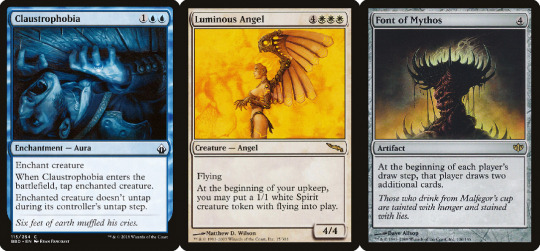
Your untap step is right at the start, when all your permanents untap. Simply turn them right-side up. Claustrophobia would prevent one of your opponents’ creatures from untapping, rendering it useless as an attacker and blocker, as well as preventing its tap abilities from being used. No player gains priority during the untap step, and play immediately proceeds to the upkeep step.
Normally, nothing happens here, unless an ability triggers. For example, the Luminous Angel gives you a 1/1 token on your upkeep. Players will get priority, so you’ll have a chance to cast instants or activate abilities as well.
After that is the draw step. You immediately draw a card, and abilities like that of Font of Mythos will trigger. Again, priority passes around. Once you’ve finished with the draw step, move on to your main phase.
Side note: Normally, players will typically condense these three steps into one (untapping and drawing), because it’s rare that you do play something here, but the steps are distinct for those cases in which you do need to take an action.

As mentioned above, your main phases are the only times you can play lands and non-instant spells, as well as activate planeswalker abilities. They sandwich your combat phase. It’s uncommon for cards to trigger during your main phases, but the two above are prime examples of such cards. Many activated abilities will also have an explicitly written restriction to only use them during your main phases.

The combat phase is the most complex, as it is really made up of five to six distinct subphases. First, you declare that you are going to move to combat. This will trigger cards like Hazoret’s Favor, and will give your opponents an opportunity to subdue your creatures before they can attack but after you have a chance to cast relevant non-instant cards.
Once priority is passed around, you move to the Declare Attackers step. Here, you will tap each creature you want to have attack, meaning you can only attack with untapped creatures, and declare the player or planeswalker it will be attacking. Creatures do not attack other creatures (this isn’t Hearthstone), and instead your opponent will have a chance to block your creatures with their own.
This happens after priority is passed around and you move to the Declare Blockers step. Your opponent will choose which of their untapped creatures they want to block your attacking creatures. Each creature can block up to one other creature, but any number of creatures can block one creature.
Next is the Damage step. Here, each unblocked creature will deal damage to the player or planeswalker it’s attacking, and each blocked or blocking creature will deal damage equal to its power to the creature(s) it’s been pitted against. If one of your creatures is being blocked by multiple, you need to divide its power among them. For example, a 3/3 being blocked by two 2/1′s must deal 1 damage to one and 2 damage to another. All creatures who have been dealt more damage than their toughness die and are put into the graveyard.
The theoretical sixth step actually occurs before the Damage step - the First/Double Strike step. If any creatures with first strike or double strike are involved in the combat, this step will be created and those creatures will have an opportunity to deal damage before other creatures. For example, if a 5/1 with first strike is blocked by a 3/3, the 5/1 will deal 5 damage to the 3/3 before it has a chance to fight back, and the 3/3 dies. Double strike means the creature deals its damage twice - during this phase and the regular combat phase.
Finally is the End of Combat step. Similarly to the Beginning of Combat step, this is mostly a formality, but some cards do trigger here (such as the Wall of Cinders), and priority is passed around.
Notice that you also get priority after every one of these phases, meaning you have tons of control over what happens. This allows you to play combat tricks. For example, say you attack with a 4/4 and your opponent has a 4/2. They might think you just want to trade creatures (meaning both die) and blocks your attacker. Before damage, you have a chance to play Giant Growth, pumping your creature out of range of your opponent’s creature, so yours survives.

This is also a great time to cover the keyword abilities I’ve been bringing up throughout, as many of them concern combat. Many of them are fairly self-explanatory, and are not exclusive to creatures.
Deathtouch: Whenever this creature deals damage to another creature, that creature dies.
Defender: This creature can’t attack. Often seen on Walls.
First Strike/Double Strike: As mentioned above, these let the creature deal damage before other creatures. Double Strike means it deals damage twice, once in the first strike damage phase and once in the regular phase.
Flash: You can play this card at instant speed. Can appear on any permanent card.
Flying: This creature can’t be blocked except by other fliers and creatures with Reach.
Haste: This creature isn’t affected by summoning sickness.
Hexproof: This can’t be targeted by your opponents’ spells and abilities. This doesn’t prevent it from being affected by “choose” or “all” effects.
Indestructible: This can’t be destroyed by damage or effects that say “destroy”. It can still be sacrificed, exiled, or given -X/-X to reduce its toughness to 0.
Lifelink: Whenever this deals damage, you gain that much life.
Reach: Can block creatures with flying.
Shroud: Like Hexproof, but also prevents you from targeting it (for example, with a pump spell or equipment).
Trample: Excess combat damage can be dealt to your opponent. However, you still need to deal lethal damage to any blockers. For example, a 5/5 with trample being blocked by a 2/3 must deal at least 3 damage to the 2/3 so that you can deal 2 damage to your opponent.
Vigilance: This creature doesn’t need to tap when attacking.
Menace: This creature must be blocked by at least two creatures.
There are many, many more keyword abilities, but these are the most common - the rest you will come across as you explore the different sets and planes.

After your second main phase comes the end step. In reality, you’ll care more about your opponent’s end step, because it is the optimal time to play removal, card draw, or other useful instants because it will give your opponent the least amount of time to react before your next turn. However, once priority is passed during your end step, check if you have more than seven cards in your hand - the maximum hand size. if you do, the cleanup step is created. Here, you must discard down to seven cards, and there will be another chance for priority after that. Seven is the default maximum hand size, but there are many cards that let you play around with that.
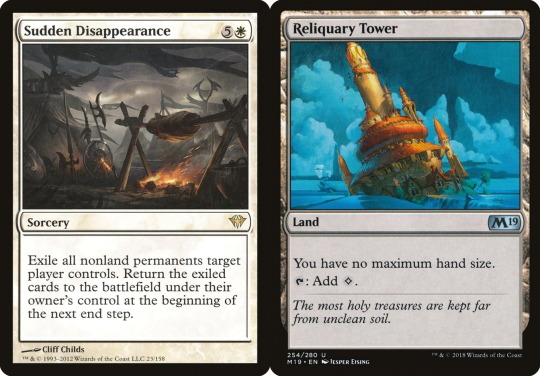
So now you’ve got your deck, you’ve mulliganed as you need, you’ve played an Island. I see you preparing to cast that Opt - but wait! Casting a spell is quite a bit more complex than it first seems, so let’s go over that now.
9. Casting Spells and Activating Abilities
All this time, I’ve been talking about casting and activating without really explaining exactly what that means, so now let’s make sure you know what that means. There is a lot of nuance to properly casting a spell, but once you understand it, you can ignore all the decorum in most cases. However, it’s still important to know exactly what happens to prevent common misunderstandings, and because Magic is full of strange cards that love to bend the rules; you will doubtless find fun corner cases.
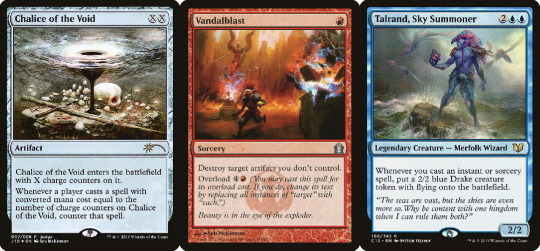

The steps to casting a spell and activating an ability are identical except the first, so I will be going over them together, referring to casting a spell.
Declare you are going to be casting the spell by putting it from where it is (generally, your hand) onto the stack. An ability will be put onto the stack as an arbitrary object.
Declare all the additional and alternative costs you wish to pay (for example, Vandalblast’s Overload cost), the mode of the card for split cards (such as Assure // Assemble) and double-faced cards (such as Alrund, who is also a bird on his other side!), and define the value of X (such as for Chalice of the Void), which you can pay for in mana of any color.
Choose the targets of your spell. You must have a legal target for each time the word “target” appears on the card (this is when effects such as “When this becomes the target of a spell” are triggered and go on the stack, to be sorted out and resolved later).
Now determine how much you need to pay. This includes cost reductions and additional costs, such as for Torgaar, as well as taxing effects (i.e., “noncreature spells cost {1} more to cast).
Activate mana abilities, such as those from your lands and mana rocks, and pay all costs as required. This means, for example, that you can tap a creature that produces mana and sacrifice it to pay for Torgaar.
Congratulations! Your spell or ability is now on the stack. Abilities that trigger while you are casting your spell, such as Talrand’s, will be on the stack above it and will thus resolve first. We covered fizzling before, but to clarify, a spell will fizzle only if all its targets are no longer legal, either through dying, or gaining Hexproof, or some other means. This means you get no part of its effects. If it has multiple targets, and only some become illegal, the card resolves as normal.
Like I said, you really don’t need to understand all of this in depth, but it helps clarify the occasional odd rules interaction.
10. Abilities
There are four types of abilities that you might find on cards. The one we’ve just covered extensively was activated abilities, which further come in two forms.

Draconic Disciple handily features both: a mana ability, and a normal activated ability. Notice that all activated abilities use the syntax “Cost X, Cost Y: Ability.” As we covered last chapter, you need to use mana abilities before paying costs when activating an ability, so you couldn’t tap Draconic Shaman for mana for his own ability as well as tap him to summon the dragon.
The main distinction for mana abilities is that they don’t use the stack, resolve instantly, and can be used while casting spells. An activated ability is considered a mana ability if and only if all it does is create mana. That means that Deathrite Shaman’s first ability is not a mana ability, because it exiles a land in addition to creating a mana.
The three other types of abilities are triggered abilities, passive abilities, and replacement effects.

Vanquisher’s Banner features a passive ability by giving all your creatures of a certain creature type +1/+1. It’s pretty straightforward: a static ability simply applies as long as the permanent which has it is on the battlefield. There are nuances in “layering”, but this is already far more complex than you’ll need to know for the majority of games. Feel free to read that article, though.
Vanquisher’s Banner’s third ability is a triggered ability - an ability that goes on the stack when something happens. This could be casting a spell, a creature entering the battlefield, or drawing a card - or just about anything. These are generally in the form “When” or “Whenever”, and should not be confused with replacement effects.
Replacement effects, like the one seen on Teferi’s Ageless Insight, come in the form “If... would... instead”. They are similar to triggered abilities in that they occur in response to something happening, but they don’t use the stack. Instead, think of them as modifiers to abilities. For example, if Teferi’s Ageless Insight was formatted like a triggered ability, drawing you a card each time you drew a card, you’d be stuck in an endless loop of drawing. Instead, replacement effects only apply once to each thing they modify.

There are many ways that abilities might manifest themselves, and they don’t always need to be on the battlefield. Bridge From Below’s wall of text works when it’s in the graveyard. Skyscribing’s ability only works from your hand, and is keyworded by Forecast, which only appeared in the original Ravnica set.
The best way to experience all the different interesting abilities and cards is just by playing and expanding your collection. Enjoy playing around and learning more about the game.
This is just about all you need to know to understand the game itself. However, Magic cards just love bending the rules, so you’ll always be encountering interesting rules interactions that will teach you more about the game as you play.
11. Formats
Here is where the fun really begins. Choosing a format is like choosing a social media platform: it comes with its own drama, flavor, speed, and player personalities. All formats use 60 card decks with 15 card sideboards, and start at 20 life, except Brawl and Commander. Each format has its own banlist, so make sure you check that before building just any deck. However, feel free to totally disregard all formats and just build whatever deck you want to have fun with friends!
Here are the most popular formats:
Standard: Probably the most popular 1v1 format, Standard uses cards from the last few sets, and constantly rotates. Deck prices can range from under 100$ to over 500$ when certain powerful cards are in rotation, but when a card rotates out, it can lose its value if it isn’t played in older formats. It can be competitive, but also lets you play with fun new cards in a weaker environment.
Pioneer: The newest official format, Pioneer uses cards dating back to the set Return to Ravnica. It has the same fresh feel as Standard, but doesn’t rotate and is closer in power level to Modern.
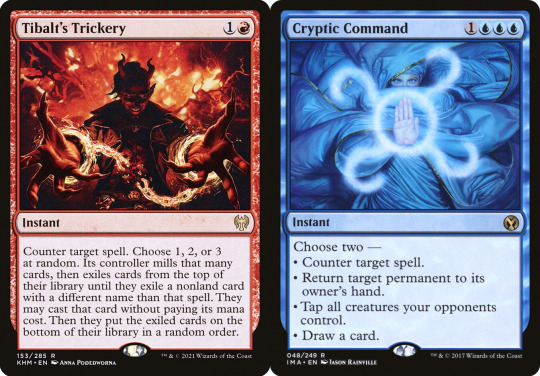
Modern: This format uses cards from the newest set all the way back to Eighth Edition from 2003. Decidedly more powerful than Standard, and expensive as well. Competitive decks can range from 200-1000$, but the vast size of the card pool means you can find budget builds and underdog decks to tinker with.
Legacy: You can use any card in the history of Magic, except those from the Banlist. The power level is incredibly high, yet the stereotype of 2-turn games is not as true as one might think. Because of the original dual lands, decks are often over 1000$, but mono-colored decks such as Burn can be brought down to 200$. Definitely not for the faint of heart.

Vintage: Like legacy, all cards are at your disposal, and this time, instead of a banlist, you have a restricted list, meaning you are limited to 1 copy of certain cards. A single copy of Black Lotus can be tens of thousands of dollars, and is a staple alongside the rest of the Power Nine. Very few play it because of the price tag, but it lets you tap into the true power of the oldest Magic cards.
Commander (AKA EDH): Play with any card, like Legacy, but with the distinct Commander banlist. The deckbuilding process here is very different: Pick a legendary creature you like, and pick 99 more cards that are of the same color(s) as your commander. This is a singleton format, meaning you can only have one of each card except for basic lands. Commander is also a multiplayer format, played in pods of 3-6; most often 4. Your commander starts in the Command Zone, where you can cast it. Each time it dies, it goes back to the Command Zone, where you can replay it for an additional 2 mana each time. The multiplayer nature, 40 starting life total, and high variance make Commander incredibly casual, much more a social event than a game. Have fun casting huge spells, playing pet cards, and embodying your commander. That being said, there’s a competitive scene in EDH, known as cEDH.
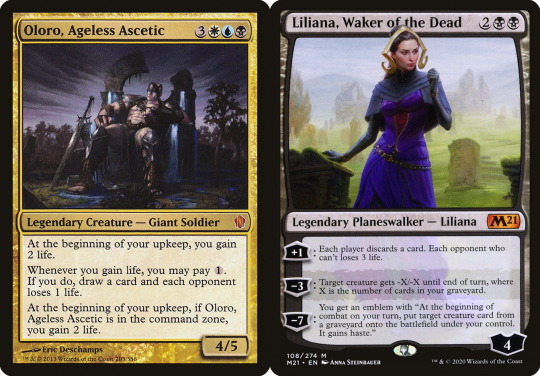
Brawl: Ah, Brawl. Commander’s younger, forgotten brother. It’s a cross between Commander and Standard, in which you have a commander (in this case, it can also be a planeswalker) and must have singleton copies of cards. Like Standard, you can only use cards from the last few sets, your deck is only 60 cards (no sideboard, though), and games are 1v1. You start with 25 life. Almost nobody plays this in person, but it’s very fun on MTG Arena.
12. Where to Play
Assuming you don’t have a group of friends ready to accept you into their playgroup, finding people to play with can be hard. First, I’d recommend checking Wizards of the Coast’s official Store Locator to find local game stores that might be hosting events and selling cards. If you go to their websites, they’ll often have calendars listing events by date, format, price, and prize. Explore and find one you like. MTG players are generally friendly, and will be willing to accept you into their playgroup, teach you about the game, and maybe even let you borrow a deck!
If you don’t feel like playing in person, there are several online options.
Magic Online (AKA MTGO or MODO) is the primary official way to play. Pay 10$ for an account, and you can buy, sell, and trade cards as if they were real. No really - Magic cards are almost like stocks, and MTGO cards are basically digital versions of Magic cards, so their price will generally mirror their real world counterparts, albeit at a lower price.
Magic Arena (MTGA) is the newest official online game. It only has cards from recent sets, back to Kaladesh, as well as a few odd cards hand-picked for Historic play (a format specific to the game that uses all cards available). Because of the smaller card pool, MTGA is limited to Standard, Brawl, and Historic as the primary game modes. However, it is free to play and your collection can’t be traded, so you collect cards somewhat like Hearthstone.
There are also a few unofficial programs, including Untap.in, XMage, and Cockatrice, which are free and give you access to the full range of cards for testing new decks before you buy them in paper.
Make sure you keep track of MagicFests, official conventions hosted both around the world and online, to meet tons of new people and play in competitive events.
Ultimately, though, many people choose to play at home around the kitchen table with friends and family. Play wherever and however you feel most comfortable; after all, Magic’s best aspect is self-expression.
13. Accessories

Credit: Tolarian Community College
If you’ve visited a local game store by now, you may have noticed that they sell way more than just cards. There are a myriad of accessories you can use to personalize your game and protect your cards.
Dice: from D4′s to D20′s, you can find these in countless colors and styles. Have fun picking your favorite and use them to keep track of life totals, counters, tokens, and more.
Sleeves: These can come in many different colors and designs, but vary wildly in quality. Pick the ones that feel right for you. These will help you shuffle your deck with ease and prevent your cards from getting damaged. Inner and outer sleeves provide additional protection for your most valuable and prized decks.
Deckboxes: Again, tons of variation. The right deckbox for you will depend on how many cards you want to fit in it, if you want space for dice, the design, and much more.
Playmats: These provide a sleek surface for you to easily pick up, tap, and move your cards around. Pick ones with your favorite Magic art, or order one with your own.
Trade Binders: Once you’ve built up a collection, you might have a few valuable cards you want to show off. Put them in a trade binder, and approach people to find other neat cards you might need.
Tolarian Community College on Youtube provides the best reviews of popular accessories, rating and testing them thoroughly. He also dishes out incredible commentary on new sets and the state of the game. Probably the most popular MTG Youtuber out there.
14. Further Resources
You’ve made it this far, but there’s still so much to explore! Here, I’ll be listing plenty of websites that are excellent resources to expand your understanding of the game.
The official rules: Quite dry, but this is where to go if you ever find a confusing interaction.
Tolarian Community College: I just discussed him, but I must reiterate how awesome his channel is.
Scryfall: A powerful search engine for all the Magic cards you might be looking for. What I’ve been using for card images this whole time. WOTC’s official Gatherer pales in comparison.
TCGPlayer: My favorite way to order cards online, but alternatives include Card Kingdom, StarCityGames, and ChannelFireball.
MTGGoldfish: An excellent all-round resource for keeping track of metagames, card prices, and interesting articles and gameplay. You can also use it to find, build, and share decks and see their prices.
EDHREC: This site conglomerates EDH decks from around the internet to give you a condensed list of the best cards by commander. A must-have resource when building new commander decks.
Last but not least, the best way to learn to play Magic is to watch others. I started out by watching gameplay from Grand Prix’s and other competitions on Youtube. Even though I barely knew what the cards were, I quickly picked up the most popular ones, learned common play patterns, and more. You don’t need to be a pro to learn from them.
15. Have Fun!
Yeah, it’s cheesy, but as I’ve reiterated, Magic is a game of self-expression. With thousands of cards to pick from, plenty of formats, styles, and accessories, customize your play experience as much as you want and be comfortable with that. Meet new people, participate in trading, and play in local events. Magic is what you make of it, so make it the best it can be.
30 notes
·
View notes
Text
“magic is hearthstone now lol”
I’m taking a second shot at talking about Magic this week, because things happened and everyone is required to have an opinion on it.
In the hallowed words of a meme from a discord I’m in, “COME ON, 5 second without drama”.
Or without yet another spoiler season this year. Even if there’s a huge number of players this doesn’t actually affect, this still makes a total of 9 releases (10 if you count Mystical Archive, more if you count other little things) for the year so far, and we’re only just getting to August. That’s kind of insane.
So what the fuck did WoTC do this time?
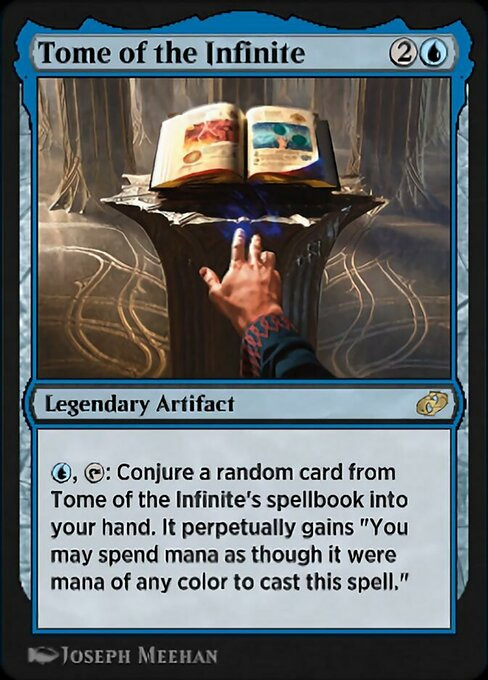
Oh.
Huh.
While I’m sure someone stumbling across this post on Tumblr is going to know already, I also know that some of my mates read this and haven’t played Magic since, like, 2016, so I’ll give a brief explanation of Historic.

Historic is a Magic: Arena only competitive format that encompasses every card available on the program; this includes every Standard set from Ixalan onward, as well as “special” sets such as Jumpstart, Mystical Archive, and the Kaladesh and Amonkhet block Remastered sets. Some of these special sets, as well as the occasional “Historic Anthology” drops, have served to inject specific cards into the format- as an example, May’s Anthology 5 included several Artifact-themed cards, some Flashback spells like Ancient Grudge, the Phyrexian Praetors, and the Dragons of Tarkir Commands. In essence, Historic is like the Modern of Arena.
This format is pretty cool, though due to the huge number of releases it can be relatively volatile. This new news comes hot on the heels of the suspension of Brainstorm- a temporary period before it’s decided whether the card should get banned or not.
And what is that news? Well, Jumpstart: Historic Horizons, apparently. An injection of 782 new cards to this format, which will likely completely and utterly change how it looks and plays. Many of the new cards are highlights from Modern Horizons 1 and 2, which will likely lead the format to play much like the paper format that was those sets’ namesake.
However, not every card in the set is a reprint, and that’s where the controversy comes into it. 31 cards are new, digital-only cards with effects that by-and-large would be difficult to impossible to replicate in paper. Comparisons to digital-only card games like Hearthstone and Eternal were inevitable, as was the bitching from players that the game is Ruined Forever. Alarmism and fatalism and all that fun stuff I got sick of approximately 10 fuckbusted mythics ago.
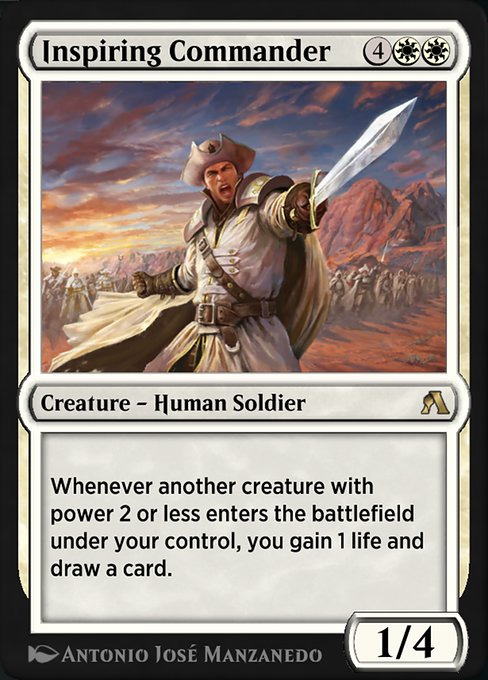
For reference, these are not the first and only MTG: Arena, digital only cards. The program has a small handful of cards intended only for the New Player Experience- a tutorial, really, but you can keep them. Most of these cards are about as terrible as that comment suggests, but there are some exceptions that people are upset about- Goblin Gang Leader basically being a possible second copy of Beetleback Chief for singleton formats, and I’m sure the 15 people playing Ogre tribal would love Ogre Painbringer, but it isn’t good. The only real standout is Inspiring Commander, a card that would legitimately be good in a lot of white EDH decks, but without a paper printing, isn’t likely to make it into them anytime soon.
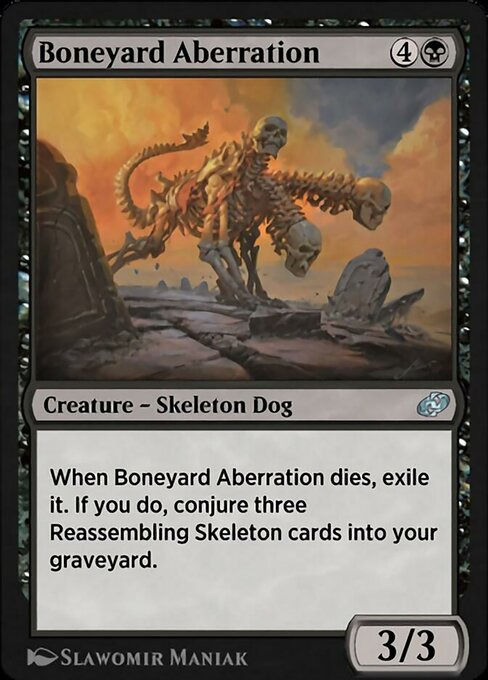
The key difference between these and the Jumpstart: Historic Horizons cards are that these could be printed in paper, whereas those ones absolutely could not (Well, mostly). They feel a lot like the Playtest cards from Mystery Booster, which were frankly a lot of fun. Davriel’s effect reminds me of many a Hearthstone card- particularly Kazakus, what with basically not explaining any part of what the card does and involving much RNG. Pool of Vigorous Growth is literally just Momir Basic on an Artifact, and Shoreline Scout just puts fucking Tropical Island into your hand. I’m not saying you couldn’t try some of these effects in paper, but I am saying you probably shouldn’t bother.
And that is, in part, why I am actually not worried, like, at all for the state of Historic, or Magic in general, with the release of these cards. For one thing, we’ve seen 22 of the 31 new cards at time of writing, and pretty much none of them are likely to break into the Historic format in any significant level. They just aren’t powerful enough, especially considering the other cards added simultaneously- fucking Yawgmoth and Ponder are here, not that many people are going to play Baffling Defenses. I’m sure one or two will pop up in Historic Brawl, but that format is inherently sillier anyway.
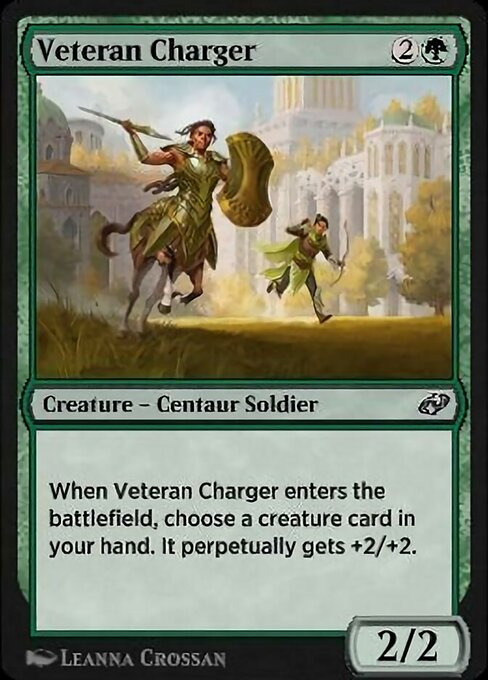
I’m of the opinion (and to be fair I’m ready to be wrong about this) that the digital-only cards in JHH are mostly just going to be a fun quirk for the limited format. Honestly, some of these look interesting enough for me to consider playing the game for the first time in months. But the majority power level on them is just that, Limited fodder, and I’d be surprised if many of the rares/mythics really took over like certain ones from the first Jumpstart did. Looking at you, Muxus.
And WoTC isn’t stupid. What this set, Jumpstart Historic Horizons, is intended to do is three pretty clear things.
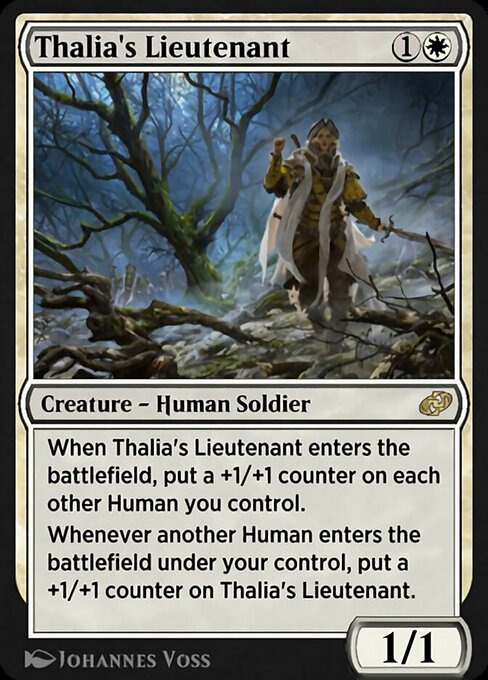
Firstly, it’s to push the Historic format closer to what paper formats like Modern and Pioneer look like in power, while also potentially spicing it up with cards from other formats (I don’t know, we might see a Commander card or something). This is good, actually, because it gets us closer to actually having those competitive formats playable online without resorting to the distressingly old MTGO client.
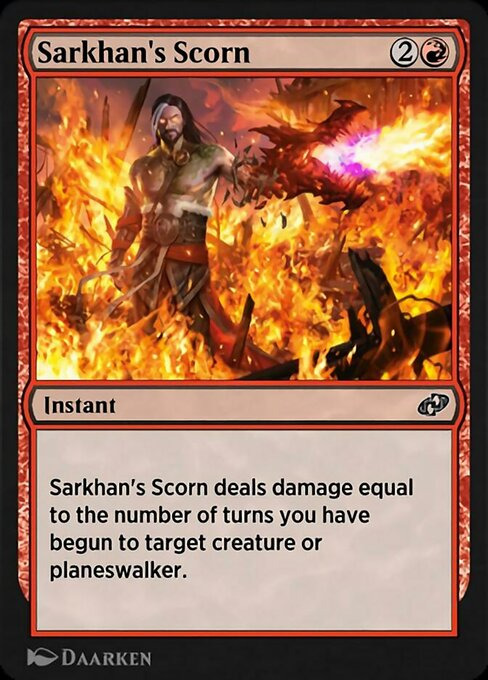
Second, it’s to experiment with digital-only design. I’m kind of surprised Historic is the testing grounds for this, but for now, it’s ultimately probably fine. If the format was so utterly ruined by these cards that people really start rocking the boat, I’m sure they’ll make a separate format for these. Whether or not we se more in future depends a lot on the response to this set.
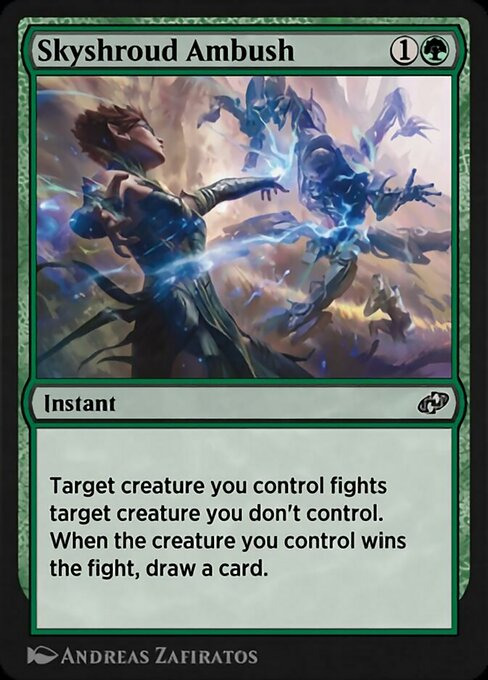
Thirdly, it’s just another Jumpstart set. I understand the first one was very popular on Arena, though I never played it, but it means that people are going to be buying in to events, and buying gems for Wildcards for all the new stuff. It’s going to make money. But hopefully it’ll be fun doing it.
I really do wish people weren’t so doomsday about these things, because I want to be able to express a positive opinion on things without getting my head cut off. Tome of the Infinite looks fun! Sarkhan, Wanderer to Shiv is cool, and I like the recontextualization of Shivan Dragon as a card- same with Kiora and Kraken Hatchling. And I want more cool, powerful cards on Arena, so that funky formats like Gladiator and Historic Brawl have more to play with.
So I guess what I’m saying is, I’m cautiously optimistic about Jumpstart: Historic Horizons. God knows someone has to be.
4 notes
·
View notes
Text
The Upside to Downsides

Let’s talk some more about downsides! They are an important staple of MTG, having existed since the very first days of Alpha. Their existence ebbs and flows, but drawbacks are an important tool in any designers Balance Belt™. Let’s break it down!
Synergy
One thing you always want to pay attention to when putting a drawback on a card is synergy. Does the drawback play into the rest of the card? If the creature has to attack each turn, then is it the type of creature that wants to attack? It may sound odd to say that drawbacks should fit the card- what with them being drawbacks- but the reverse leads to cards without purpose or place. A high-cost creature that enters the battlefield tapped is incredibly difficult to put in a deck, since it won’t be able to block the turn it’s cast and you won’t be able to do anything else that turn, so you’ll just end up dying. Make sure the drawback feels appropriate for the card.
Too Much Synergy
Counterpoint: it’s easy to steer too far in the other direction. After all, a downside still needs to be a downside, and if it plays into the rest of the card too well, what’s it playing against? If you have a creature that attacks each turn if able, but it’s unblockable and has one toughness, then it’s not like you want to hold it up as a blocker anyways! If you’re giving a card a downside in order to temper out the design, make sure that the rest of the card doesn’t render the downside irrelevant.
That’s not a REAL Drawback!
This is an argument you hear sometimes. Is Decayed really a drawback when it lets you trigger morbid? Is a downside if it lets you bluff a pump spell more easily? The short answer is yes. Don’t get blinded by potential. While synergy is cool and important, so long as a downside has situations where it is unfavourable for you, then that’s all it takes to be considered one. Ultimately, the term is colloquial and lacks a strict definition, but in most cases, it’s pretty clear one way or another. As for the corner cases? Well, we’ll look at those if they come up.
But the Flavor
Something we see a lot is drawbacks that play into card flavor. A peaceful warrior who can’t deal damage, a spell that can only be cast at night, or a demon that eats your own creatures. Downsides are a great way to really hammer home the connection between flavor and mechanics, as it forces a particular event instead of leaving the choice up to the player. This is a great tool in your arsenal, but it can be dangerous. If the downside doesn’t match up flavorfully, or the rest of the card is pulling too hard in another direction, you end up in a bit of a discombobulated puddle. Use the flavour to inform the downside (and the rest of the card), but don’t allow it to dictate everything. After all, as we know, mechanics trump flavor. This is, first and foremost, a game.
Symmetry
There is also the argument to be made that giving an opponent an upside is the same as giving yourself a downside. Totally true! If you play a creature that allows your opponent to make a bunch of tokens, that’s a downside! Where it gets a little murkier is a perfectly symmetrical effect. Is “Each player draws a card” a downside to “you draw a card”? Technically, sure. I’m definitely not gonna disqualify a card that does that this week. But ask yourself how it’s using that downside as an effective part of the design. If the card just does the symmetric effect and nothing else, well then it feels less like a downside and more just like that version of the ability. How does the downside inform the rest of the card? That’s what you should ask yourself here.
A Note on Color
There are a few exceptions, but typically speaking, you don’t have to worry about downsides breaking the color pie. The color pie is concerned with allowing too much mixing of beneficial abilities, but downsides are almost always fair game for whatever card needs them. Since you can always choose to block with a creature, a creature that forces itself to block can be any color that it needs to be (depending on the rest of the design, of course). Any color can force you to sacrifice one of your own permanents, even if some colors lean into it a little more. However, just because there’s a mechanical justification doesn’t mean there aren’t still limitations. After all, you are limited by player expectations. Why is black the color with the most downside cards? Because black’s whole deal is “power at any cost”, which lends itself naturally to these designs. Sure, Abyssal Persecutor isn’t technically a pie break in green, but would it make sense? Not at all! So don’t worry about breaking the color pie with your downside, but make sure that your card as a whole still feels right at home in the color(s) you put it into.
That was a whole chunk of text, but I hope you enjoyed reading, and I can’t wait to see your designs!
3 notes
·
View notes
Text
My (Current) Thoughts on MtG Universes Beyond
I've sat on my feelings for most of the day, sort of thinking them over, and I think I want to share my present feelings on the topic.
I'll put my extended thoughts below the break, but or a quick version: I'm not against other properties being allowed to use the MtG ruleset for their own unique takes on the game with cards created from the ground up to represent their properties, but people shouldn't be forced to interact with them if they play formats other than standard. @wizardsmagic should create a format, or variations on existing formats, to allow for mixed property play, to allow people that want to blend these properties together to do so, but otherwise restrict Universes Beyond properties to playing only amongst themselves. That is the only way I see this keeping the game from becoming an incomprehensible mashup or unrelated properties.
Right off the bat, I just wanna say, I don't hate the concept of using the Magic: the Gathering rules and mechanics for other properties. I really don't.
Magic: the Gathering is arguably the first TCG to exist as we know them today, and it's also the longest running. It nailed what needs to be done in a card game, and many other games have tried copying its style to varying levels of success. It is a game that works, and it works well. The idea of using that amazing rule set, but with the flavor and lore of a different world or universe, is actually quite interesting to me. Why fix what isn't broke? Why does every property have to have it's own totally unique rules? Like, I see nothing wrong with wanting to play Magic, but with a different lore behind it.
There's also a lot of potential to be had here, that I don't think some people are seeing. Much like with the Walking Dead cards, Universes Beyond will include cards designed from the ground up to fit their respective properties. In MtG, certain things in the game behave the way they do do fit certain lore and traits unique to the MtG multiverse, but those may not apply when looking at a different property. Perhaps colors will play slightly differently, or creature types will behave in different ways. Yes, these properties will be using the rules of the game, but that doesn't mean the same design philosophies will be in mind in exactly the same ways they are in MtG.
All of this said, I want to be perfectly clear: the way Wizards of the Coast has decided to do this is flawed, and it entirely comes down to a lack of respect for the integrity of their own property.
There are many players, myself included, who like this game because it's not Lord of the Rings, because it has it's own lore. MtG has almost thirty years of lore behind its belt, and while said lore has been rough at times, it's a lore many still like, and seems to be back on the right track with the reintroduction of free web stories.
Yes, the Universes Beyond cards aren't allowed in Standard, that's great, but nothing has been said of other formats. If someone wants to go to the table and play Commander or Modern, and part of their enjoyment comes from the lore behind the cards they're playing, the arguable identity of the game, they shouldn't have to deal with Gandalf facing off against their Chulane deck.
And referencing something I brought up earlier, this says nothing of the way the new cards could potentially interact with the game in an unbalanced or otherwise harmful way.
I think the perfect way to have done this, to do this, is literally let the cards only interact with their own franchises, and maybe introduce a new format, or variations on existing formats, that allow anything with the "Universes Beyond" branding, perhaps including actual MtG cards in that as well, sort of an anything goes format. I urge @wizardsmagic to consider this, please.
If they don't find some way of separating these cards beyond different art/frames/whatever, in a few years, we're going to end up with games of magic that have Optimus Prime fighting Sauron, and while there's nothing inherently wrong with that, it's sort of like going to watch Jurassic World and suddenly the Smurfs are involved in the plot. I didn't buy tickets to Jurassic World to see the Smurfs, I didn't buy packs of Magic: the Gathering to sit down and play Warhammer.
I buy/play Magic: the Gathering because I like the brand and identity of Magic: the Gathering. I am a Vorthos more than anything else, and my enjoyment of the game literally hinges on my love and respect for the worlds and characters Wizards of the Coast have spent so long lovingly crafting for us. Let other brands use the rules of the game, fine, there's nothing wrong with that, but make them their own games. Please. All you have to do is say they aren’t allowed in any current formats, and create variations of those same formats where anything goes. It’s just that easy.
5 notes
·
View notes
Text
VOC’s Review of the art of Magic The Gathering Core 2021
I an no art expert. Never studied art professionally. But I do consider myself a Vorthros (someone who appreciates the art, story, and flavor of Magic The Gathering). So I have been wanting to this for a while so let’s try it. If this is liked then maybe I will do it again for Zendikar Raising. I’m not going through every card in the set. Just a handful that really stood out to me and I just want to talk about.
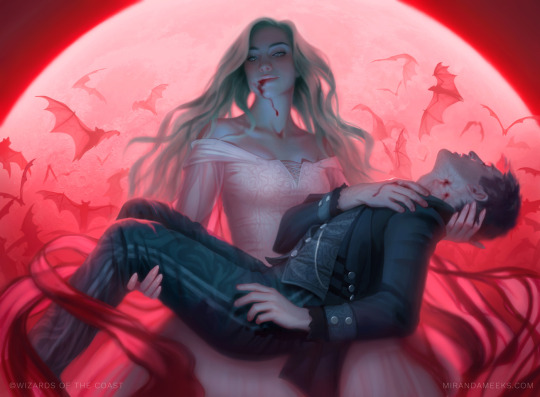
Indulging Patrician by Miranda Meeks
Normally I like to save the best for last but this one is so obviously the best art in the set that I need to lead with it. When I first saw this card revealed my jaw dropped. It is purely captivating! It embodies what vampire artwork wants to be. From the powerful dominant vampire woman in the center, to her poor powerless victim, to the beautiful blood moon behind her, to the swarm of ominous bats, all highlighted with blood. Of course the traditional gender role reversal feels so perfect and not forced here. It is a beautiful artwork and you should want to play Magic just to look at this card.

Liliana's Scorn by Josh Hass
We are not moving away from the gothic horror yet though. This is sadly a card that most players will never see as it isn’t in the Core 2021 booster packs but is in the Liliana planeswalker deck. Making this art very easy to overlook but quite impressive when examined. You really feel the struggle of the victim as he fights a losing battle against a horde of zombies. Being in the center you might think he is the protagonist that we cheer on to escape but Liliana even in the backgrounds steals the scene and you know she wins this fight. This is just a great group piece where each individual zombie displays a surprisingly amount of depth which truly makes this piece feel even more hopeless for the poor victim and even more empowering for Liliana.
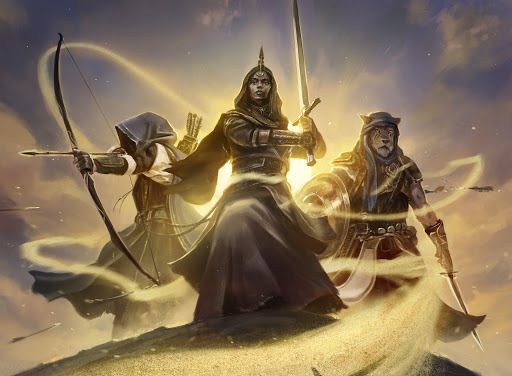
Basri's Solidarity by Paul Scott Canavan
Basri Ket is a new planeswalker in the set but instead of looking at him directly let’s check out his magic instead. This is a piece that perfectly embodies cooperation and teamwork, Each figure looks quite a bit different, has a different background, and a different specialization. Yet they are all subtlety bonded together through the sand that basri controls. The way it wraps around and protects them all it a cool and powerful effect.
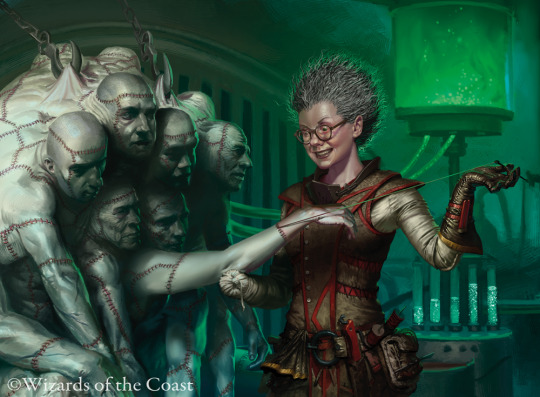
Obsessive Stitcher by Joe Slucher
And we are back to dark and creepy. But I can’t ignore in crazy details in this artwork. On Innistrad, the doctor Frankenstein-like scientists that create ‘zombies’ though alchemy and science rather than straight-up necromancy are called “Stichers”. And this one piece explains all that without any words (except for the 1000 words a picture is worth). The corpses all have different faces showing that this is not simply a construct made from a generic stock but instead were actual living human beings at one point. The ominous green vat behind her is hooked up to them pumping them full of something that can’t be good. Plus we also have ominous test tubes in the background to really hammer in the point of “evil mad scientist”.But then her actual clothes has lots of handy tools to show a devoted craftsman. As she literally stitches thread through not only her diabolic experiment but also her passionate artwork. And finally I did not even notice until seeing the enlarged art but she is missing her right hand! I assume this counts as positive disabled representation right?
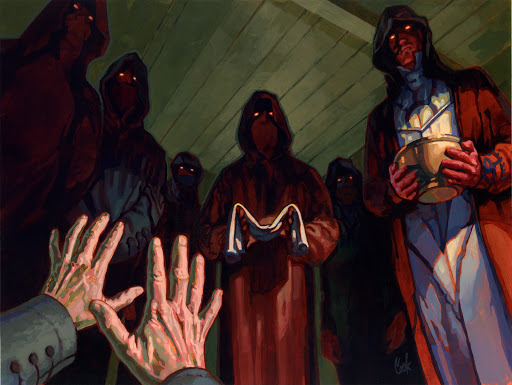
Village Rites by Bud Cook
I promise this is the last dark and creepy card (maybe) on the list but I have to give this one a shout-out. It is a throwback and homage to the card Village Cannibals from Innistrad. Even the same artist. Definitely one of my all-time favorite MTG arts so I am very happy to see a remake of that art! It is nice when Magic throws in the little nostalgia winks randomly.

Tolarian Kraken by Svetlin Velinov
Magic will often use what they call “Scale Birds” to show how big something is. These are tiny birds near a creature to show how much bigger the creature is than the birds and give a size comparison. Sometimes birds are too small and they use something like “”Scale Deer” or other mammals. Well then those are still too small we now have a “Scale Castle”! What is more terrifying than a Kraken this big! As if that isn’t bad enough it’s brain is actually visible and has like lightning coming from it or something. This feels like a very epic piece where you can feel the motion and terror from it.
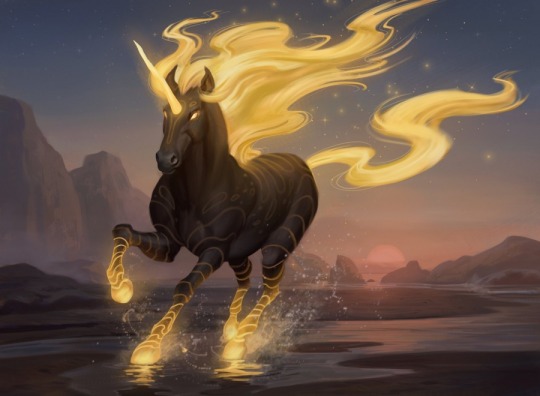
Daybreak Charger by Forrest Imel
The next several arts are going to be under the category of “Things MTG does all the time but needs to make it new each time.” I feel it is most appropriate to start with this unicorn. You see unicorns take occupy a very unique position in both general fantasy genre and pop culture itself. Unicorns are very recognizable so they are very much a great fantasy trope to include. But they also have a reputation of being aimed at “young girls” and in the process made to seem very soft and non-threatening. MTG is a game about combat! You don’t want to summon a gentle non-threatening creature to fight for you but it wants to have unicorn cards. Meaning it wants “badass unicorns!”. Well they absolutely succeed here! But the beautiful thing is they need to over-correct. It wasn’t necessary to paint it all black and cover it in blood. We don’t need to put it on a heavy metal album cover to show its fierce side. Instead bright light is used in a way that makes it seem comforting but also powerful and not to be messed with. This is a unicorn that you are relieved to be on your side and terrified of seeing on your opponent’s side. That takes serious talent to bring it all together!

Chandra's Incinerator by Craig J Spearing
First I apologize that this art is a little cropped from the original. What is another thing that shows up all the time in fantasy art? FIRE! It gets hard to draw fire so often and make it feel different. This is a fire elemental so that is a bit different but still something we have seen a lot. The card Fire Elemental was in the very first Magic set. That card has had 4 different artworks and 3 other cards have some for of Fire Elemental in their name (Deepfire Elemental, Firefiend Elemental, and Wildfire Elemental). This one is clearly meant to be a nostalgic nod to the original art and it works so well! The fire is so detailed and intimidating but the creature is very expressive. It is very refreshing to see yet another Fire Elemental in such a new fashion and perspective.
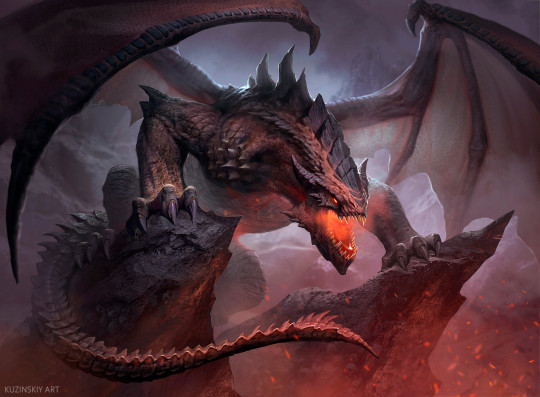
Terror of the Peaks by Andrey Kuzinskiy
How many times have we seen a dragon in MTG? Over 200 times!! This set alone has 3 dragons! We have seen zombie dragons, skeleton dragons, dragons who breath lightning, dragons that breath frost, dragons covered in metal, and all kinds of other dragons. But sometimes you just need to go back to basics. But basics do not need to be boring. As we see here this is an awesome basic dragon that embodies everything you think of when you think of dragons yet still blows you away with how awesome it is! This is quality dragon art

Shacklegeist by Igor Kieryluk
Ghosts and spirits are again a common trope that gets redone a lot. I really like how this piece can just take a mundane object with some symbolism behind it and just make an entirely new creature from it. This is basically a giant lock with ominous chains attached being held by a specter and it all works so well together! This art style being more watercolors is a nice final touch to give this piece a spooky feeling but also a really cool feeling too.
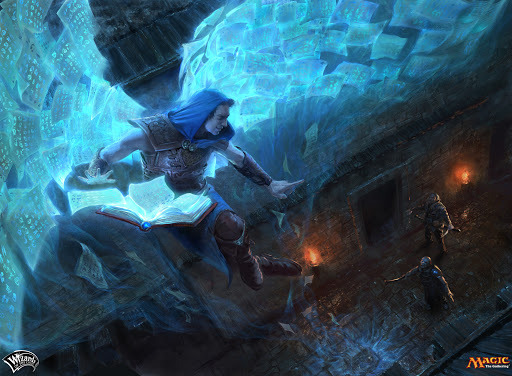
Rousing Read by Campbell White
I am going to end this with a bit of a weird piece but I didn’t want to leave it out. This is apparently a follow-up to the card Hard Cover from the core set before. This guy has magical wings made from the pages of a book! Like I don’t have anything else to add. That is cool enough by itself.
Special Mentions
Alchemist's Gift, Chandra Heart Of Fire, Garruk’s Uprising, Peer Into The Abyss, and Sanguine Indulgence. All cards with awesome art but I don’t want this post to go on forever (and some of them I couldn’t find good clean versions of just the art). Please tell me what art from Core 2021 I missed that you really liked!
1 note
·
View note
Note
Why do you think the website stories Formant is not really being used? I have no idea personally.
I don't have any inside information that allows me to say FOR SURE what is behind the format change, but I can make some educated guesses.
I think the main thing that it comes down to is corporate politics. Specifically, Hasbro executives don't really "get" Magic: the Gathering on the whole, and that's a problem for the people at @wizardsmagic who make the game.
Like, I think Hasbro execs recognize that MtG makes them money. They like that. They certainly want to see more of that. But they don't really understand what it is and why people like it. So for years, they've been content to just quietly ignore it and let it do its own thing, and that's worked out pretty well for everybody involved.
So what changed this? I'm guessing two things, mainly. One is a change in leadership when Wizards of the Coast got a new CEO. (But honestly, changes like that aren't that uncommon, and I haven't heard any stories that Chris Cox has brought all that many changes to the company.) I think the bigger factor is most people's least likely suspect: The Magic: the Gathering Movie.
*crickets*
OK, let me explain. In January 2014, it was announced that Hasbro and Fox Studios had reached a deal for Fox to produce a Magic: the Gathering major motion picture. This got a LOT of hype, and then it got NO hype, because it seemed like nothing was really happening for a long time.
No big deal, movies take a long time to go from concept to screen, right? Sure. So everybody is just kind of quietly waiting for any updates, and REALLY hoping it doesn't end up as crappy as the Dungeons & Dragons movie.
But as the years roll on, there are ZERO updates. And for a movie deal that got so much hype early on, this is... odd. Like something is stuck in the pipes behind a wall that we can't see.
On the bright side, Magic's story team is absolutely NAILING IT for fans during this time. They've switched from kind of cluncky novels that only a handful of people ever read, and switched to short stories published online called "Unchated Realms." These short stories keep getting better and better, and get more and more interconnected so they become more episodic than standalone.
They become so popular that they drop the name "Uncharted Realms," and just call it "Magic Story."
Now let's take a moment and turn our attention back to that theoretical clogged pipe behind the wall. Maybe it's not so much "clogged" as much as it lacks any water pressure.
You know what movies require a lot of to make? Money. You know what the annual operating costs for Magic: the Gathering are? I certainly don't, but I'm betting it's nowhere near cinematic financing levels. You know who does probably have that kind of budget? Big Papa Hasbro.
So now we come back to that old "We ignore you, you ignore us" arrangement that seems to have worked between Wizards of the Coast and Hasbro for so long. If this movie is going to happen, WotC probably needs Hasbro to use its money (or at least its corporate clout) to move things along. But Papa Hasbro isn't just going to hand over the keys to the NICE car to Quirky Teenager WotC without supervision. (Most of the time they don't understand half the things the kid is saying!)
And thus begins the process of proving to Papa Hasbro that they CAN be trusted with this, and they CAN speak the same language, and gosh golly look at THIS dad are you proud of me yet?
Because here's the thing. Transformers movies are crappy, but Hasbro keeps greenlighting them. My Little Pony: Friendship is Magic is NOT crappy, and Hasbro is happy to keep greenlighting new content for them too. Know why? Because they're considered "mainstream" and "popular culture" intellectual properties.
In contrast Magic: the Gathering is considered "counterculture." And that's not too bad. Hasbro owns LOTS of counterculture IPs. And they love them too, in their own special way. They just don't get the keys to the nice car and other privileges like the mainstream kids get.
So now Wizards of the Coast REALLY needs to shift it's gears to make Magic: the Gathering "mainstream" if it ever wants to get this movie made.
So now let's pump the brakes for just a minute and ask WHY people at WotC really want this movie to be made so badly. Why? Well first off, I don't think all of them do. I think plenty of people at WotC would be perfectly content to just keep designing the game and writing stories and making other MtG products to sell.
But who do they sell them to? Well, existing Magic players for starters. That's their most stable customer base. But it's also a very finite pool of consumers. And people get out of that pool all the time. So how do they get more people IN that pool?
Traditionally, new players have been introduced to the game either through friends who already play, or through events at local game stores and other venues. But that kind of growth is gradual. WotC has certainly tried various marketing campaigns in the past to accelerate that growth, but few of them have seemed to be all that effective in the long-run.
But a MOVIE on the other hand... Even a movie that doesn't do great at the box office can still do a great job of increasing marketing exposure and media attention. THAT could be the marketing bomb that finally causes a sudden BOOM in customers and sales!
(Not to mention the fact that if the movie IS a hit at the box office, that further solidifies Magic's status as "mainstream.")
OK, let's un-pump the breaks now and see if we can start wrapping this up.
So in order for WotC to get Papa Hasbro's respect (and money) they need to show how "legitimate" they are as a mainstream pop-culture product. So they need to show them evidence Hasbro execs can actually recognize.
They need NAME RECOGNITION. But how? Invite famous game designers to design a few cards in a core set? (No, Papa Hasbro thinks "famous game designers" is an oxymoron, and looked at us funny because they think we said "corset.") They can't use famous actors, because THAT would require a MOVIE which is what they're trying to make happen already!
So WHO will Hasbro execs recognize as legitimately famous, who has some reason to work with us? Famous authors? "I mean, we DO have stories that need to be written, right? Of course we already have a story team who writes those, but we could just fire them or move them to different teams. Yeah, that could work..."
But again, there's a problem. "Famous authors" may not be interested in writing web fiction instead of books. Also, it's not really cost-effective. Also, Papa Hasbro still doesn't understand what "web fiction" even is, and asks us if it's anything like those forums with Optimus Prime and Rainbow Dash getting pregnant all the time.
OK then, books it is!
Now how much of this is accurate? In all honesty, I have no idea. Like I said, it's all just a series of educated guesses.
Having said that... I think they are at least PLAUSIBLE educated guesses.
P.S. Oh, and apparently Disney recently announced that they're cancelling a ton of Fox movie projects, including the Magic: the Gathering movie. So if my speculation above was correct then all of that ended up being for nothing anyway, except maybe convincing the Russo Brothers to direct the MtG Nexflix series. (And also Netflix is probably dying soon and the rainforests are being burned by a nationalist government and America's president is seriously unhinged and the ice caps are melting and OH LOOK I NEED TO GO READ THE WILDERED QUEST AGAIN BYE!!!!)
#mtg speculation#mtg fandom#mtg movie#mtg story#mtg story speculation#mtg meta#hasbro#fox entertainment
32 notes
·
View notes
Text
Mtg Custom Card Competition Round 2: Phyrexians on Ixalan
Hello everyone and welcome back to the second week of I and Alyssa's custom card challenge. Just a quick foreword to thank everyone for the warm response we have had to the last round of judging, it is always nice to see people throw feedback back at us for running it. This weeks prompt was provided by Alyssa where participants were asked to present a theoretical Phyrexian corruption of Ixalan. As always submissions were gathered through discord and were judged by myself and Alyssa.

Michael says: So our first submission of the prompt, this card is a powerful reanimation and board control effect stapled onto a phyrexian corrupted dinosaur. However the power level, especially for a rare, is what has me most concerned. The colour pie is fine and the card feels very black, there are no problems in that regard. The part that has me worried is that the reanimation is instant, comes at a low cost, and is a replacement effect. Once Corruptosaurus is on the battlefield, and if itself gets a -1/-1 counter, it becomes almost impossible to deal with as traditional measures such as rest in piece or leyline will do nothing to prevent this effect. Additionally because the return is instantly rather than at the end of turn as with Marchesa, the Black Rose it opens the card up to some silly loops with persist cards or anything that has -1/-1 counters built in. While the card is slow to distribute -1/-1 counters, their existence on this card implies they exist elsewhere in the set which will make this card much stronger. Especially in limited this card would be a nightmare as -1/-1 effects your opponent controls will be useless against your creatures and your own also feature as a steal effect. In order to make this card feel a little less broken and more fair I would restrict the resurrection to either only your own creatures or only your opponents. The potential value engine of this card seems a little above the curve as-is, especially when considering older formats with access to things like black sun’s zenith. There isn’t a single factor that pushes this card over, its just a confluence of factors that would make this card just not fun to play with and too warping in the limited environment.
Alyssa says: Formatting is mostly fine. The third ability shouldn’t be a replacement effect, because as written it inappropriately uses “return”. (Because the word return requires a card to be in the graveyard, and this replacement effect means that you gain control of the creature instead of it dying, it never enters a zone it can “return” from.) As written now, it resurrects friendly things with -1/-1 counter on them, meaning anything that has a -1/-1 counter either endemic to it (Bloodied Ghost, Grief Tyrant) or has permanent persist can be infinitely looped by it. You’ve accidentally prevented some abuse like Disciple of the Vault and Blood Artist by replacing the death trigger, but you can still benefit immensely from the infinite sacrifice. Furthermore, it just makes immortal creatures.
Balance-wise, it’s doing a bit much. The endemic wither is fine, giving it a way to damage stuff and get it back, and it would tie well in with the third ability like a souped up Necroskitter. The second ability is completely unnecessary, though perhaps more novel. You really only need one of these for the card to be useful for Limited and narrow Constructed applications (which is where this thing feels like it belongs.) It would be so much better if you went with only one of these abilities: I prefer the second one, as the incremental infection-based effect, perhaps through infected bites or claw injuries, seems much more “dinosaur” than a resurrection effect.
Flavor-wise, it’s okay, but it’s a bit bland. It’s a zombie dinosaur that does vague infection stuff. There’s not much of a story to the card, and a bit of flavor text with the space freed up from the above changes would be just dandy. I want to see how it fits in with the set around it, how Ixalan responds to its new apex predators. You have no art credit. We wouldn’t have noticed that “Mr. J” wasn’t an art credit if someone else didn’t use that art and credit it correctly.
Possible improvements:
- Focus on one of the two passives and cut the other. If you wanted to focus on the incremental blight aspect, then perhaps make it asymmetric and only affect your opponent’s creatures.
- Fix that malfunctioning third ability if you decide to stick with it.
- Flavor text never hurts.
- Drop a reminder text bubble on Wither for easier reading comprehension.
Grades:
Formatting – 4/5
Function – 3/5
Flavor – 2/5

Michael says: This card appears to have a serious flavour issue which really hurts the mechanical execution of the card. The flavour text indicates a phyrexian merger of Ghalta and Etali, something I would expect to have a similar importance as Brisela from Eldritch Moon, however the rest of the card appears to instead by an Ixalani call-back to Phyrexian Obliterator. This card feels like two excellent ideas combined to a less effective whole.
Judging by the perspective of an Obliterator call-back this card feels like a very good way to make a dinosaur version of the card, using enrage as an in theme way of simulating the desired effect. However in this case the card doesn't feel very green at all, outside of the dinosaur tribe and enrage there is nothing mechanical to make this card green. Given the enrage effect is symmetrical and only sacrifices a single land, if you had to keep the green in the mana cost rather than making it BBBB you could probably improve its power and toughness. Additionally if we assume this card is representative of the rest of the set, it is important to note that Wither and Enrage really do not play well in the same environment as wither -1/-1 counters will not trigger any enrage abilities on blocking. I personally would look to replacing wither with another ability, preferably one that is more green to help reinforce the colour requirements.
Again the card isn't particularly bad by any means, but the foremost improvement I would make is replacing the flavour text. The combination of Ghalta and Etali shouldn't be as small as a 5/5, should certainly be a legendary, and should at least cost red. The dissonance of these two ideas harms the card severely.
Alyssa says: Wither shouldn’t be capitalized. In a list of keywords, only the first one is capitalized. When you’re writing quotes in flavor text, make sure you put a shift line break in between the end of the quote and the beginning of the speaker’s name. The card feels barely green at all: in fact, I wouldn’t be surprised to see this as red/black. The only bit that really strikes me as possibly green is the trample, which is secondary in black anyway. Enrage is also really hard to trigger intentionally in black, making abuse of the ability in its two intended colors very difficult.
The enrage ability is beyond busted. I understand you want to reference Phyrexian Obliterator and its extremely powerful on-damage ability, but remember that ability can only be as strong as it is because there’s very few ways for you to abuse it, since the controller of the source sacrifices the permanents. There’s tons of enrage enablers that would allow you to use this to repeatedly Armageddon the board. You may think its symmetry compensates for it, making it a “risk vs reward” play, but if you’re building around it the play will never be symmetrical. If you have one of the many ways to reliably damage this each turn you can just pop every land your opponents play consistently, and you’ll have a giant 5/5 that can wear down literally anything over time provided it doesn’t die. There’s a reason people play Armageddon despite the “this includes your lands” line, and making a repeatable version on top of a strong creature isn’t a good combo.
But it’s the flavor which really grinds my gears. The implication is that the Obliterator is some kind of Brisela-like chimera of Etali and Ghalta… which completely doesn’t gel with the card itself. It’s not legendary, it’s less than half the size of Ghalta, it has none of Etali’s lightning stuff or draw power going on. It looks like a generic compleated dinosaur, which would honestly be completely fine if it weren’t for that flavor text implying this was an amalgam of two of Ixalan’s Elder Dinosaurs. It would be similar to Brisela being, like, a 3/3 Eldrazi with a card draw ability.
Possible improvements:
- You need to find a way to make it green. Perhaps play on the legendary Phyrexian resilience and have it punish by getting bigger when it takes damage. Or perhaps have it dredge its way out of the graveyard at end of turn if it would die from combat damage. Who knows?
- Figure out a new enrage ability. This one is ridiculously easy to turn into Armageddons For Ever.
- Use some new flavor text. If you’re dropping story characters, then you need to reflect their abilities, roles, and legendary status.
Grades:
Formatting – 4/5
Function – 2/5
Flavor – 1/5

Michael says: A compleated Azor is a very interesting concept from a lore perspective, and his card would surely excite players to see printed. This card however I am not sure would accomplish this feat. His mana cost is highly colour intensive meaning he is very difficult to cast in any normal game, therefore I would expect to see a reward equivalent to the effort I put in to cast him. In addition to possessing no built in way to protect himself, his effect feels incredibly weak. While seeing your opponents hand is noteworthy, in the vast majority of games when you cast Azor you are likely to be in the later stages of the game. At this point your opponent has likely already cast most of their hand and if not you are playing against control in which case Azor is never resolving let alone actually attacking. And even if the effect does trigger you are only likely to draw a single card at most given the opponent will play around the effect as much as possible. In order to make this card playable its effect needs to be tuned into a specific niche; given Azor's previous identity as a control piece I would want to see an effect that works well against control to help tie the flavour into the mechanics. I and Alyssa came up with giving him "this card cannot be countered" to help give him an anti-control niche along with changing his effect to be an enter the battlefield trigger. Allowing you to look at an opponents hand, pick a card type, and producing a static draw effect whenever your opponent casts one similar to how Archon of Dawn's Reach is worded we believe would be the best way to give him a specific use worth the extreme mana investment to cast him as well as being more relevant in multiplayer.
Alyssa says: Some small formatting changes. It’s “…look at defending player’s…” rather than “the defending player’s”. You need to add a “Then” before “Choose a nonland card type” to help sequence the effect (basically, so you know you look, then declare.) Make sure you install the M15 Mainframe layout for MSE, so you get the M15 card style, holofoil stamp, legendary crown, flavor bar and text chopping.
Woah, that’s a restrictive mana cost! This gent would be underpowered at 3WUB, so making him six mana of specific colors is a bit too much. I get that it’s acknowledging Azor’s original 2WWUU, but he had two strong abilities, one with instant payoff, that necessitated four color pips. This card doesn’t, and should be priced accordingly. I doubt you’ll ever get value off of his ability. He needs to survive a turn to use it, and by that time you not only have to attack an opponent with a brimming hand, but choose a card type they’ll play loads of. It also only triggers from that player casting that card type, so if Jimmy jams all the enchantments that you just disincentivized Bimmy from playing you dont get any cards. Even so, he doesn’t stop your opponents from comboing off, and the fact it isn’t a “may” means in fringe cases he might mill you out. You might get, like, one card off this guy every two turns, and that’s far too weak. Just play Cloudblazer. This ability isn’t black at all. Becoming Phyrexian doesn’t just jack black onto your mana cost, as New Phyrexia demonstrated, and his vague lockdown/card advantage ability doesn’t do much.
Flavor-wise, I’m not sure what Azor is doing here. He’s evidently compleated, and is doing vague law things, but I just don’t see what the ability is meant to indicate. Does he demand tribute from those who would transgress his twisted law? It just doesn’t have an immediate, strong flavor resonance for me. There is also an Incorrect art credit, which also is already in use. This is the art for Sphinx of the Steel Wind, by Kev Walker, from Alara Reborn. (It’s also one of the five first Mythic Rares! The more you know.)
Possible improvements:
- Make him 3WUB. Or just make him 4WU. He isn’t strong enough to need all of that color.
- He needs protection, or a stronger ability to justify the risk. Perhaps make his ability also trigger off entering the battlefield, a la Arashin Foremost. You could also retool it into an effect that names a card type that can’t be played, a la Archon of Valor’s Reach. If you make it stronger, tick up the mana accordingly.
- Make him scale to multiplayer scenarios.
Grades:
Formatting – 3/5
Function – 2/5
Flavor – 2/5
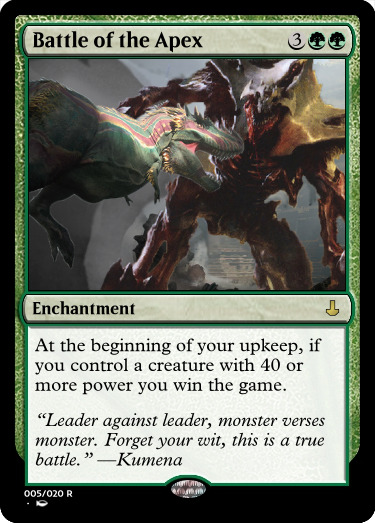
Michael says: Ok so I really enjoy this card. Its a silly win the game condition with a really crazy activator. These sorts of cards are almost always popular and incentivize weird brews in both the standard environment and in eternal formats. Also I do appreciate the effort you put in to photoshop this yourself, good job on that front. While there is nothing wrong this card in its present incarnation, I think it needs to be improved from where it is now. Phyrexia in general often has an identity of using -1/-1 counters, and so if those exist in the environment it will stop a significant +1/+1 counters theme from being present which would be a key tool making this card workable. In addition while the precedent for win the game effects has been established for the upkeep step this particular card would struggle significantly with such a timing window, as many cards that buff or double power last until end step. If we assume this set cannot use +1/+1 counters the main pathway for this card would be effects that double in power, and therefore I think you can change this effect to an end of turn trigger without much concern over power. If you have a creature with power 40 or greater you are probably winning anyway. In order to avoid confusion with the cleanup step and to improve flavour I would suggest an end of turn trigger where if you attacked with a creature with 40 or more power you win the game.
Alyssa says: You need a comma between “more power” and “you win the game” as they’re two separate clauses. You spelt “versus” wrong, and you want to add a shift line break after the quote finishes before the speaker’s name. Make sure to get the M15 Mainframe card style to add a flavor bar.
Funky, fresh, and Green! The problem is that it’s way too hard to pull off. Placing the win trigger at the beginning of the turn means you need a creature with static power 40 or more, plus instant boosts/abilities, which is really hard because it and the creature both need to survive a full turn to trigger outside of some abstruse circumstances. This just feels like it’s been made too safe out of power level concerns.
I appreciate the need for some counterplay in win conditions, but I feel it’s pretty telegraphed anyway, and if you’re getting the beefy boy that you need to win with this there’s some other enchantments for similar cost that will make your beater so ferocious it’ll probably just win you the game anyway. I feel that it’s perfectly fine to make it an end of turn effect. One variant that we like is for you to attack with a creature with 40 or more power to win the game on the end step, really playing up the flavor of the card.
That flavor is really nice, and I appreciate the photoshop. It’s really cute! I would really prefer to have the artists who made the art you’ve edited credited too (the people who painted Ghalta and Vorinclex.)
Possible improvements:
- Make it an end of turn effect to better synergise with creature buffs.
- If you want to keep it at upkeep, add an activated ability that boosts power or whatever. It’s hard to use counters in a Phyrexian set (which is going to be a -1/-1 counter set nearly all the time) but temporary boosts still work.
Grades:
Formatting – 4/5
Function – 4/5
Flavor – 4/5

Michael says: This card I find somewhat disappointing in all honesty. To give credit where it is due the templating is correct, I love the flavour text, and the card works. But it is far too safe, and that safety really hurt the card. This is obviously a call-back to the original Mavren effect, but creating 2/2 horrors with deathtouch instead. This really does impact the card in a few ways. Firstly the tokens you make are not vampires, one of the benefits of the original Mavren is that he did not need to attack, and the tokens he made would fuel his ability further so you could always swing in with a single vampire every turn and remain even on tokens. This Mavren requires a significant amount of other vampires in the deck, or to swing with himself which opens up a lot more vulnerability to the card getting blocked and killed. And this plays into my other concern as well as the creatures have deathtouch instead of lifelink. While a more powerful mechanic it promotes a slower and more defensive playstyle, which conflicts with the precedent of the vampires being the white weenie deck, in addition to meaning that if Mavren does swing it is more likely there will be creatures available to block him. Finally and this is the most important concern, he is a white card that creates deathtouch tokens. Yes he is tied to vampires, a tribe mostly in black, but he needs to have black in the mana cost or otherwise this card is a colour pie break.
Alyssa says: The formatting is just dandy. The full art is nice, but it does reveal the Legend of the Cryptids watermark and copyright information below, which really takes you out of the card. You also spelled Mavren Fein wrong! It’s a small quibble but it really, really hurts the card’s aesthetics and is something that could be easily fixed with some proofreading. Unless compleation made him shuffle his name around a bit.
This card puzzles me. For one, it’s not remotely white: Mavren Fein does produce tokens but they’re white tokens with lifelink rather than black ones with deathtouch. I don’t like the fact that mono-W can break the color pie and make deathtouch creatures relatively easily with him. For another, unlike Mavren Fein’s initial form which produces aggressive tokens with a keyword that incentivizes combat and attacking each turn, Mavren Fien’s ability produces defensive tokens instead. I’m therefore confused as to what exactly his game plan is: attack in every turn, or hunker down? There’s also balance considerations in that he does make 2/2’s, which is fine perhaps on a multicolored card but a bit much for a monocolored one, especially when it’s a color bend like this.
I also don’t like that it lets token vampires make tokens. Small thing, but the Torrezon vampires traditionally make lots of tokens so I worry that might kick it over. The flavor is fun, if a little lazy. It’s literally just Mavren Fein again, but with a slight change in some knobs. I want to see something a little more exciting.
Possible improvements:
- Proofread! So close to being perfect.
- He’d be perfect if he just cost WB. No color breaks there, and a neat compensation for being two colors.
- Is deathtouch really the best keyword for his token? Possibly look to making the tokens more directly incentivize aggression
Grades:
Formatting – 4/5
Function – 3/5
Flavor – 3/5

Michael says: Another odd infect card, this time a compleated siren with the ability to steal creatures. Firstly I really, really love that flavour text. Definitely one of the best I've seen in a while from a personal perspective, it resonates just right. My opinion on the mechanics however is that this card is pulling in two directions. Its raid effect wants it to sit back and block attacking creatures to distribute -1/-1 counters, and this would inevitably be very powerful in limited. However on Ixalan I expect to see bigger creatures than normal thanks to all the dinosaurs, which means it can be very difficult at times to block with this creature. The card really wants to both attack to activate the raid safely as well as remain untapped to block incoming attacks. While this dissonance helps to balance what can be a very potent steal effect, it would also make the card very unfun to play as you cant play in the way this card wants to. Yes a board presence and other infect creatures help to mitigate this, but by itself it will not have a good gameplay loop. Additionally this card uses art that already exists on a magic card. I'm not particularly bothered by that but it can lead to a bit of confusion so if you can avoid that it helps.
Alyssa says: You forgot the “on it” part of “with a -1/-1 counter on it.” You don’t capitalize the “The” in “the Stormwreck Sea”. Otherwise, formatting is good!
I feel mixed things about this card. On the one hand, it’s mechanically sound, on the other I’m not entirely sure how well it will play. It’s a seemingly very powerful trigger, but I worry that its implementation is internally competitive. You want to steal big stuff here, which is good, but as a 1/5 infect on its own you can only steal things that have 4 or less power that attack into Ichorfleet Despoiler. You aren’t going to be taking any Colossal Dreadmaws with this thing. Similarly, anything it can safely block will probably be worthless when you get it: it’ll be out of the way, sure, but I want more for 5 mana. If the surrounding environment supports putting -1/-1 counters onto creatures, then this could have applications, but it’s really, really bad at triggering its own ability and I think that should be taken into account.
I’m always awkward about putting infect onto things. Once again, this exposes another internal competition within the card. Its 1 infect damage means it’s going to kill people at the speed of a Coral Eel, but I don’t like that you’re incentivized to steal your opponent’s stuff, which probably won’t have infect. You want to win in infect by dealing 10 damage as quickly as possible, but because “not having poison counters” isn’t a resource, you don’t really gain much through incremental, slow upticking. If you’re stealing creatures without infect it’s like the damage this deals doesn’t even matter. In effect, it’s kind of like giving this infect has reduced its power to 0. Just give it wither, like several other entrants have twigged.
It’s a good card, but it just doesn’t sit right to me. The potential line of “attack with my dinky infect rat, get blocked by a gigantic dinosaur, play Despoiler main 2 and steal it” is really fun but once you’ve seen it once you’ve seen it all. This is a card that’s so hard to evaluate outside of set context.
The flavor is lovely, but this art is in use! It’s the art for Siren of the Silent Song from Born of the Gods. Reverse image search your images before you use them just to make sure.
Possible improvements:
- Give it wither, so it can actually attack well.
- Swap out the art for something that hasn’t been used.
- Consider making the card better at activating its own abilities, so it doesn’t rely on the context of a set that doesn’t exist.
Grades:
Formatting – 4/5
Function – 3/5
Flavor – 4/5

Michael says: So because of the nature of this card as a goblin piker I am less reviewing the card as I am the mechanic, and to be totally honest I am not super keen. The mechanic is clearly a riff on explore, providing a poison counter instead of a +1/+1 counter. My concern with this kind of mechanic is that it would struggle to exist in an environment with infect already present as they compete with similar design space and infect is often easier to get to 10 counters thanks to how it scales and is repeatable. With this mechanic you would need to trigger it and hit a non-land 10 times to win and that is almost impossible in limited if we assume the mechanic is seeded like explore was in Ixalan. Another issue here is that these poison counters are functionally useless until you hit 10 meaning that there is no real benefit for the first 9, whereas with explore the +1/+1 counters can be supremely relevant to the board. Encroach would need to be significantly pushed in how often you can activate it in order to see any amount of constructed play and in doing so could produce a harmful standard environment as these counters would be more difficult to interact with than creature damage through infect. In addition seeing this effect on a BB goblin piker at uncommon is very below rate, while this effect existed in Ixalan the explore trigger was significant in that it existed on both a 1/2 and a 2/1 while also costing one coloured and one generic mana. This card is seriously underpowered in almost every circumstance except when the opponent is on 9 poison counters and I am unsure as to how the mechanic could be tweaked and still keep the flavour of phyrexia while also working similar to explore.
Alyssa says: Formatting wise, this is completely fine. It wants to be a Soldier, though. Or perhaps a Horror, with appropriate art?
Mechanically, I don’t really have that much to say. Encroach is a very weak ability because it really doesn’t do anything to alter the game state aside from when your opponent has nine poison, which, if that is only being spread through encroach, means the first nine activations that don’t hit a land basically do nothing. With explore, both times you’re getting something, whether that’s a land card or a counter plus a surveil, but with the Conquistador you just give a worthless poison counter. It also feels very lackluster as a concept. It’s literally just explore, but with a tinge of Phyrexian spice that ironically makes it weaker. I can’t think of a set that would want this as one of its 3.5 mechanics. The card wants to be 1B rather than BB. For BB you’re getting a 2/2, or perhaps a 3/2, with that basic effect, especially at uncommon.
A big problem I have is that it’s ripped wholesale from Vraska’s Conquistador, which is also a black uncommon 2 mana 2/1 Vampire with the same art (which you didn’t credit, by the by.) There’s nothing spooky or Phyrexian about the art that tells me that this thing is encroaching on Ixalan, and there’s no flavor either. It just feels like it was slapped together in a couple minutes from Vraska’s Conquistador, even down to the name, with a mechanic that’s just Explore covered in Phyrexian graffiti.
Possible improvements:
- It needs to be overhauled from the top.
- Encroach needs some genuine thought to turn it into an incremental poison/value generation mechanic, with a benefit on top of just giving them a single poison counter.
Grades:
Formatting – 4/5
Function – 2/5
Flavor – 1/5
And finally we have our winner for this week:

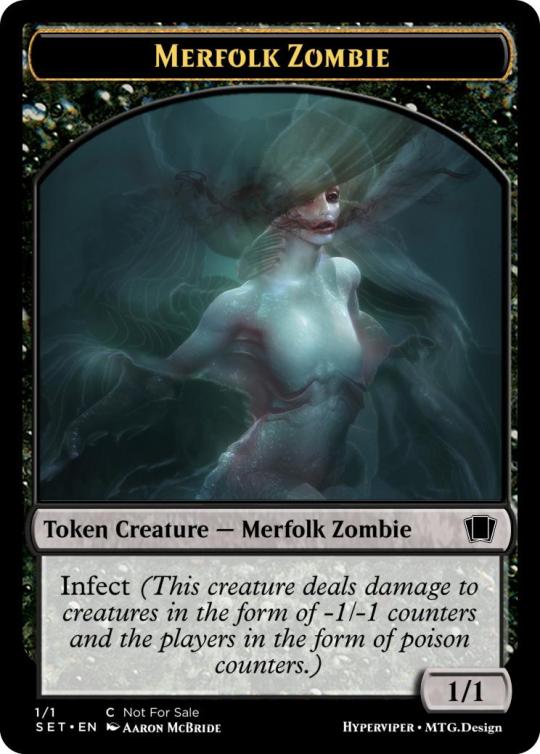
Michael says: This is a safe design, but I think it checks a lot of boxes for a good call back design while still having its own unique effect. Here the original value engine of kumena is replaced with an infect strategy which supports itself through a token creation ability that also possess infect. I also enjoy how in order to fuel his unblockability, it requires a sacrifice instead of just tapping merfolk, an elegant way of powering down the card in a very flavourful way thanks to the addition of black to his mana cost. While infect can be scary I think the limiters on dealing combat damage to players to trigger the token making definitely helps to mitigate the potential of the card. In order to break this card you would need a lot of tribal investment and synergies, which means he would probably make a strong commander but his standard impact can be well measured. In addition to this the formatting has no problems and the art was well picked for this card. Honestly it makes me sad I cant say much more about this card, its just a really good example of linking old and new flavour. The power level may be a bit suspect but I think it is correct to err on the side of caution for infect cards, especially with built in evasion.
Alyssa says: The formatting is superb. You even got the rules for multiple instances of a legendary creature’s name in a text box right! I also appreciate that you provided the token it produces.
I always get leery of infect, but I can honestly see it working here. The stats are about right (considering it attacks players as a 4/4) especially for a 3-color legendary creature. It’s not Boltable, but it has no inbuilt protection, which I feel compensates. The combat damage trigger is a little uninspired, and perhaps a little weak. I’d like to see something sexier, maybe a card draw? I can’t help but look at Phyrexian Swarmlord as a point of comparison. But I suppose incremental infect production is a decent enough compensation. Either way, I feel it’s a good implementation of infect on a creature that is its own game plan.
You could probably dink the sacrifice condition for his unblockability down to two merfolk. Going in on a -3 to then get, I dunno, Divine Arrowed or whatever is really sad. I like it being free on mana but high on card disadvantage to really sneak infect hits through.
Flavorwise, he’s a real treat. Lovely to see a Phyrexian card with a bit of personality, especially with him being all shouty up in the card art. Flavor text is actually unnecessary on this, in my opinion. His charisma and influence is demonstrated by the Merfolk he summons, his cruelty by how quickly he disposes of them for his own benefit. It’s a shame he’s not a Zombie too but the typeline is packed to the gills (ha) already.
Possible improvements:
- I want to see either the combat damage trigger a bit sexier or the unblockability trigger a little cheaper.
Grades:
Formatting – 5/5
Function – 4/5
Flavor – 5/5
So thank you to everyone who submitted a card and to Hyperviper for his winning design of Kumena, the Tainted Tyrant. As always feedback on this would be greatly appreciated and hopefully the next prompt should be provided shortly.
As a bonus please see our take on the prompt with Azor the Mad, unable to intervene in the conflict thanks to his oath limiting simply to providing a passive sanctuary on Useless Island.
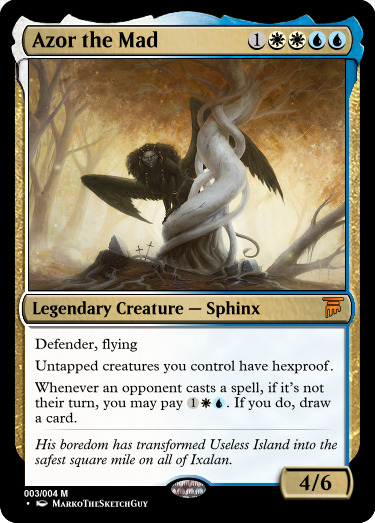
1 note
·
View note